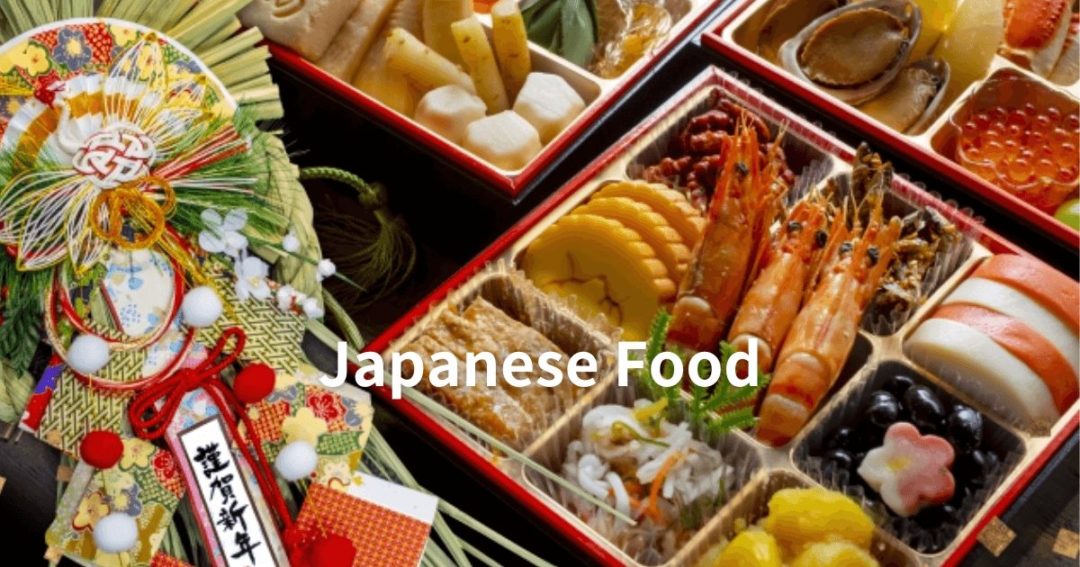Sushi
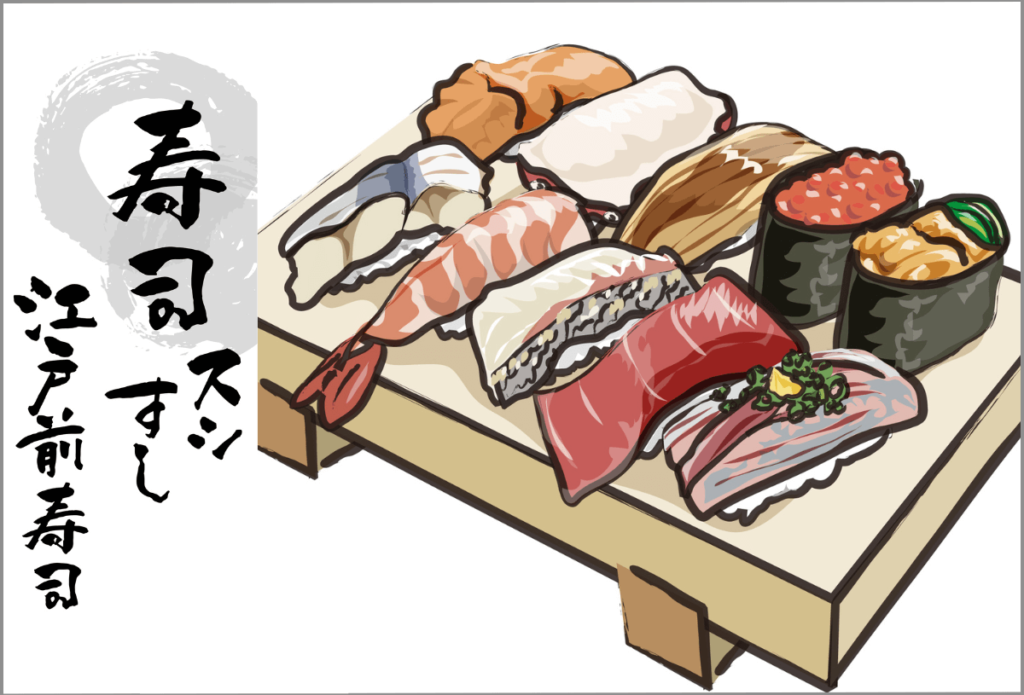
History

The origin of today’s Japanese sushi is Edomae sushi which can be traced back to when people of Edo (old Tokyo) served seafood caught in Edomae (Tokyo Bay) at yatai (food stalls) in an easy stand-up-meal style in the 19th century.
Short-tempered Edo people wanted to eat fresh seafood quickly at any time, so they invented nigiri sushi (hand-shaped sushi), a type of sushi which could be eaten with one hand, giving birth to Edomae sushi.
This Edomae sushi is the origin of today’s Japanese sushi, and is said to have been invented by Yohei Hanaya, a sushi chef, in 1810, who served sushi using wasabi (Japanese horseradish) which is similar to today’s one.
Edomae sushi at yatai was taken out as well. It is also said that people could buy Edomae sushi out of “Monouri” (salesmen) carrying it in a special box.
Features
Sushi consists of both shari (oval-shaped vinegar rice) and neta(fish fillet as topping), however sushi is not just like vinegared rice topped with fish fillet. The key is traditional craftsmanship of sushi chef.
Traditional Craftmanship #1 — Fish taste depends on technique of slice
The use of a knife to slice fish is unique. A professional sushi chef lays the knife down as far as it will go and slices the fish as if pulling it out. In this way, the cells are not disturbed and the umami (pleasant savory taste) contained in the cells remains intact. If the fish is cut in a crushing manner, the cells are crushed and the umami elements are washed away, ruining the freshness of the fish.
Traditional Craftmanship #2 — Cooking of Fish
Decorative Knife on Fish
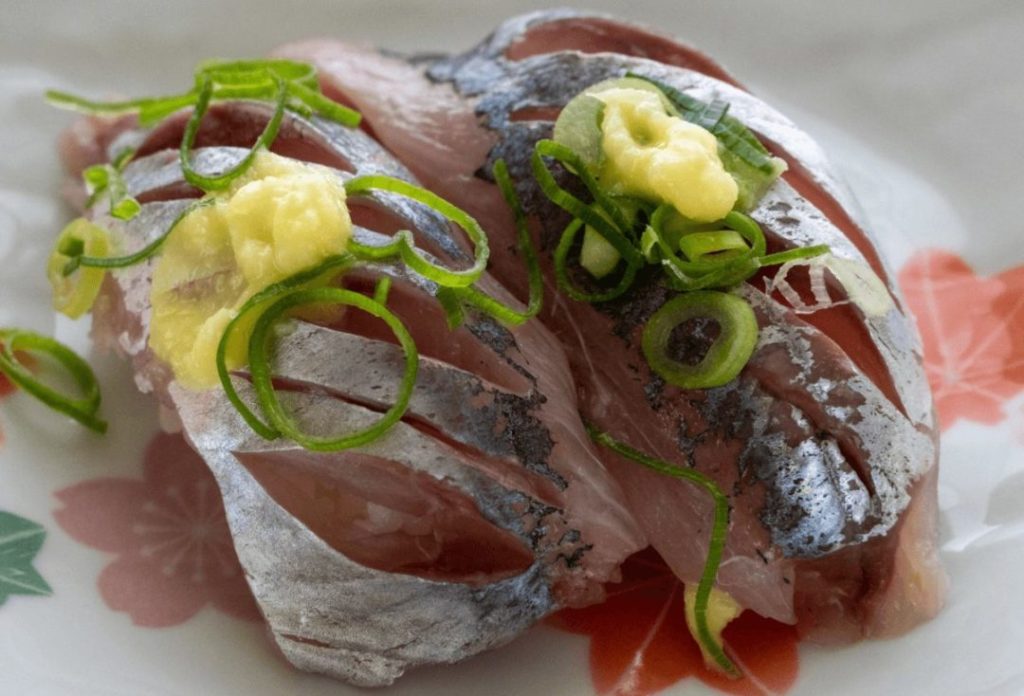
The purpose of the decorative knife is not only for visual impact, but also to allow them to melt in the mouth. There are a variety of techniques for decorative knife, and the texture and taste can vary greatly depending on the way the fish is sliced. Ginger and green onions etc. are often used to add color and brightness.
Cooking of Conger Eel
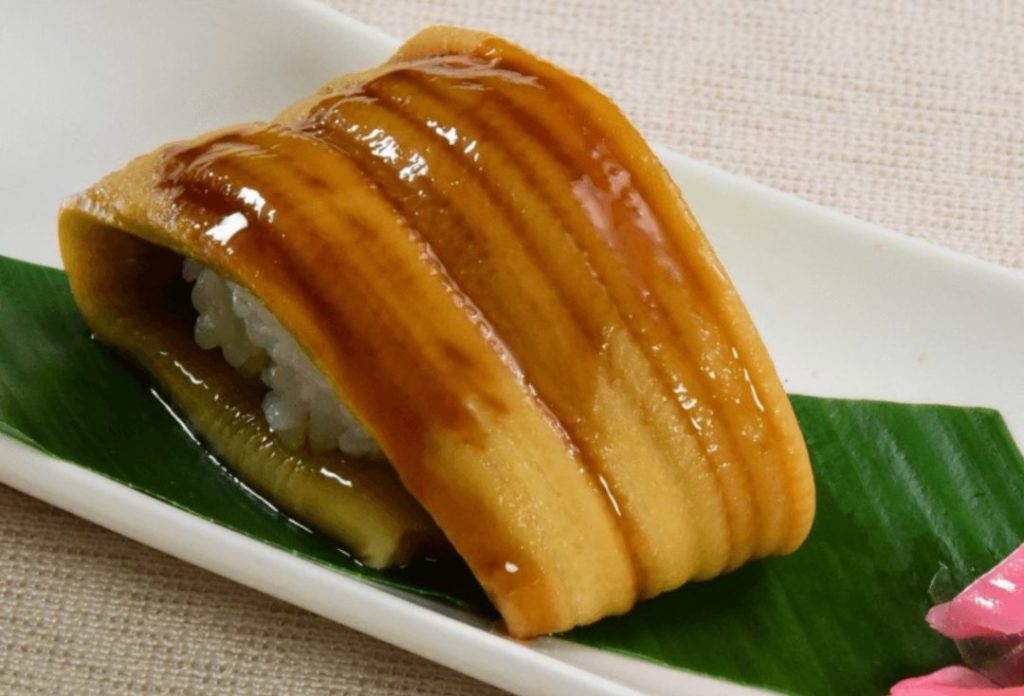
After rubbing conger eel with salt by hands, turn boiling water around to make the slime white and thoroughly remove the slime, which is the source of the odor, by rubbing with a brush. Slowly simmer over low heat in a broth made of water, soy sauce, sugar, and mirin (sweet sake) to make fluffy boiled conger eel. You can enjoy the melt-in-your-mouth texture.
Searing the Surface of Fish
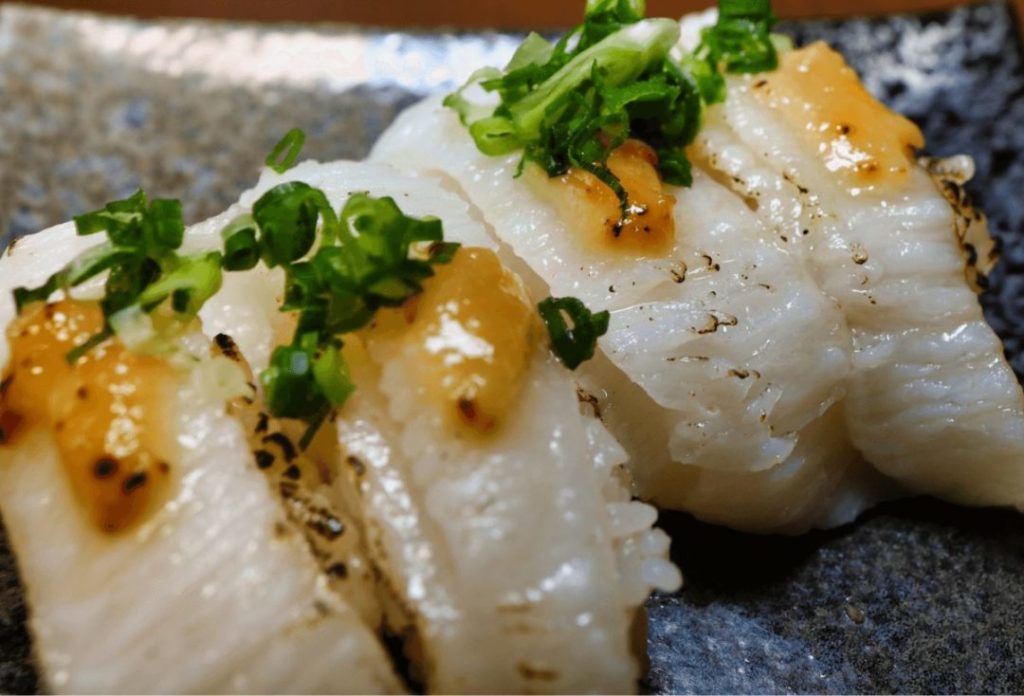
By searing the surface of the fish, the moisture is lost, the flavor is concentrated, and the melted fat seeps through to the surface, increasing the umami (pleasant savory taste). The charring also adds a savory flavor. It is sometimes eaten with miso (soybean paste) or squeezed citrus fruits. They are called aburi zushi (seared sushi), and flounder’s fin, salmon, and conger eel etc.are typical neta (toppings)
Traditional Craftmanship #3 — Space Between Rice Grains
Shari (oval-shaped vinegar rice) is made by mixing vinegar with cooked rice, and it is important that the rice not be sticky when made into shari. Therefore, “rice with low stickiness, uniform grains, and good grain separation” is suitable.
The rice should not fall apart when held in the hand, be soft and fluffy in the mouth, and the rice grains should be recognizable without being too sticky, and should have a good texture. To achieve this, the rice must be made so that there is an appropriate amount of space between the grains of rice. This is the best way for sushi chefs to show their skills.
More Deep Stories
Sushi with Red Vinegared Rice
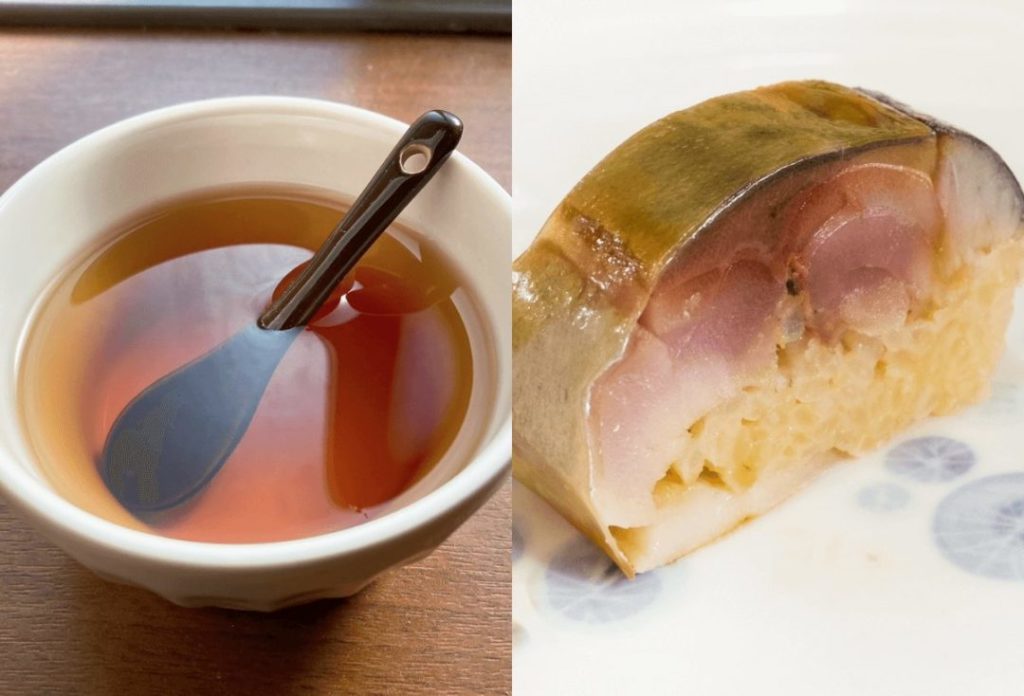
Rice vinegar is generally used for sushi, but there is a type of vinegar called akazu (red vinegar) made from sake lees. Compared to rice vinegar, akazu has a mellower acidity, more aromatic and umami (pleasant savory taste). It is also popular because it does not have the nose-tingling aroma as rice vinegar does. Recently, akazu is used mainly at high-end restaurants to make sushi with red shari (oval-shaped vinegar rice).
Sushi Tasted with Salt — Orchestra vs Solo Performance
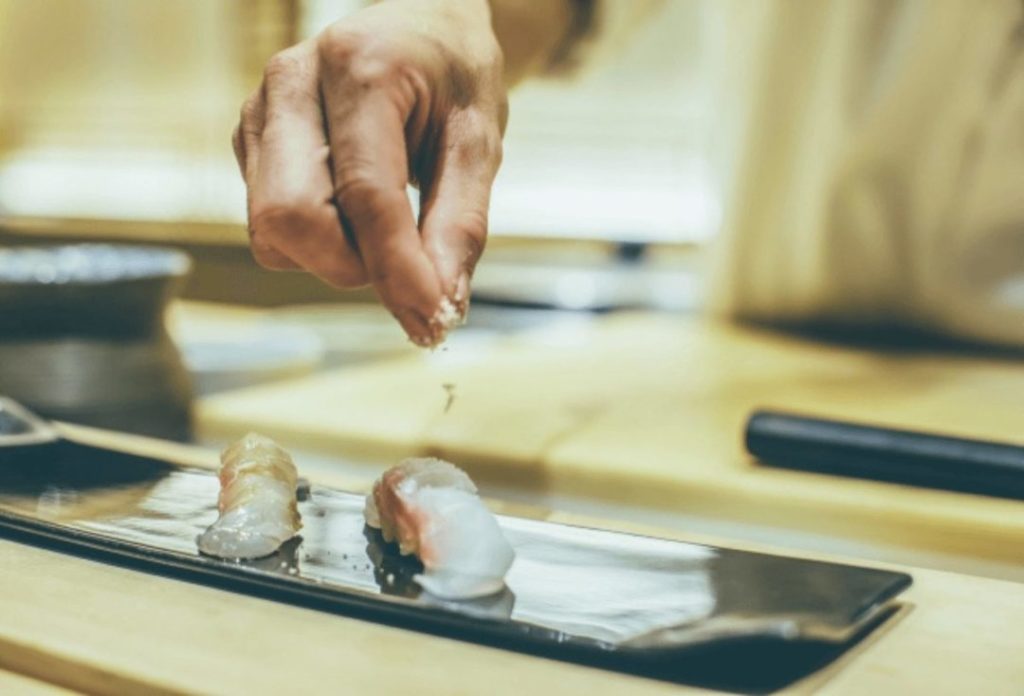
Sushi and soy sauce are a perfect combination. Umami (pleasant savory taste) from animal protein of fish and vegetable protein of soy bean are combined to create a synergistic effect, much like an orchestra playing music.
On the other hand, in recent years, some sushi restaurants have begun to serve sushi with salt. Salt brings out the flavors of the ingredients, and in this way, the original umami of the fish can be enjoyed. This one seems to be a solo performance of umami.
Conventional sushi, with its low fat content, was difficult to go well with wine. however, if olive oil is added in addition to salt, the acidity of the wine can be accepted by sushi, and it can be enjoyed with the wine.
Dashi (Japanese Soup Stock)
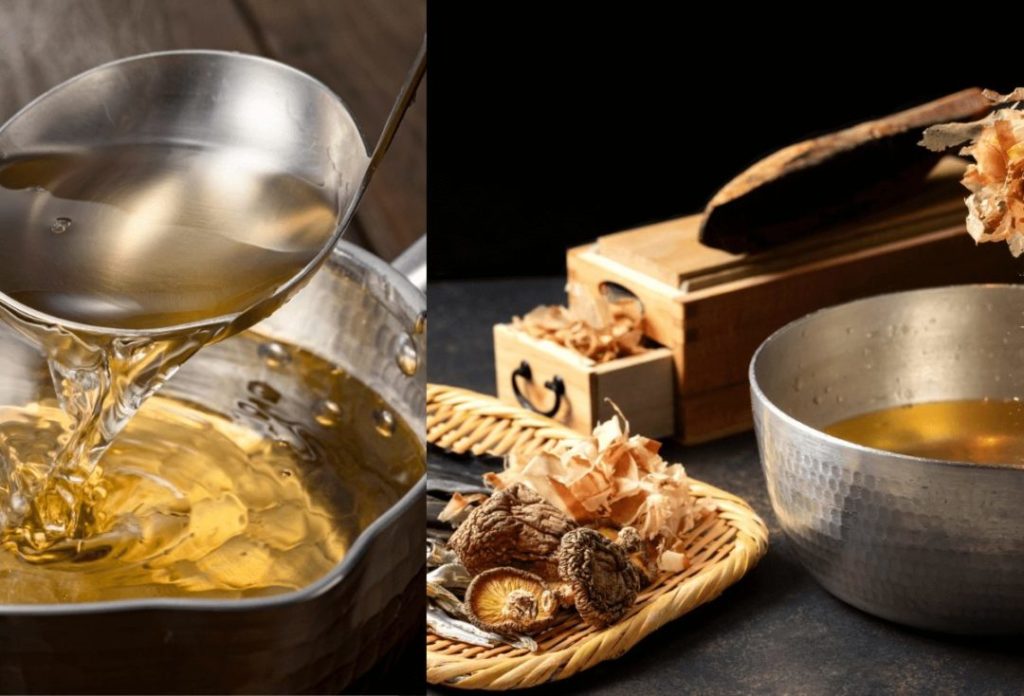
History

On December 4, 2013, “Washoku (Japanese Cuisine): Traditional Food Culture of the Japanese People” was registered as a UNESCO World Intangible Cultural Heritage. The foundations of washoku is “Dashi”( Japanese soup stock ) which serves as the base for delicate flavoring of various dishes, such as bowl dishes and simmered dishes. In other words, dashi is the “lifeblood of washoku”.
The origin of the word dashi is “ni dasu” that means to boil and extract. Adding dashi to a dish increases richness and depth to the flavor, making it possible to create a good taste that brings out the full flavor of the ingredients, even when salt and oil are reduced. This is the reason why washoku is attracting worldwide attention as health consciousness rises.
Dashi is extracted from dried-bonito flakes, dried kelp, dried shiitake mushrooms, and other ingredients by boiling. There is also dashi extracted from dried sardines and dashi from ago (dried flying fish).
It is said that dashi was developed to compensate for the lack of umami (pleasant savory taste) from animal meat in Japan, where meat eating was banned for a long time. Its history is said to date back more than 1,000 years to the Nara period, and cookbooks from the Edo period (in the 17th century) described how to use dashi.
Features
Dashi &Umami

The main ingredient of dashi is umami (pleasant savory taste). Umami is one of the basic tastes along with sweet, sour, salty, and bitter tastes, and was discovered in 1908 by Kikunae Ikeda of Tokyo Imperial University. Umami substances that form the basis of umami include glutamic acid and inosinic acid, as well as guanylic acid.
Japanese people have been using bonito dashi and kelp dashi for more than 1,000 years, probably because they knew out of experience how delicious umami tastes. The use of several dashi in combination is called “Awase dashi”, (combination dashi) and it can produce a deeper and more complex umami taste.
The first International Symposium on Umami in 1985 was the first occasion to introduce the concept of umami to the world. Chefs all over the world are now interested in umami and are continuing their research to incorporate it into their own
Bonito Dashi and Kelp Dashi — Differences Between Edo and Kyoto Dashi
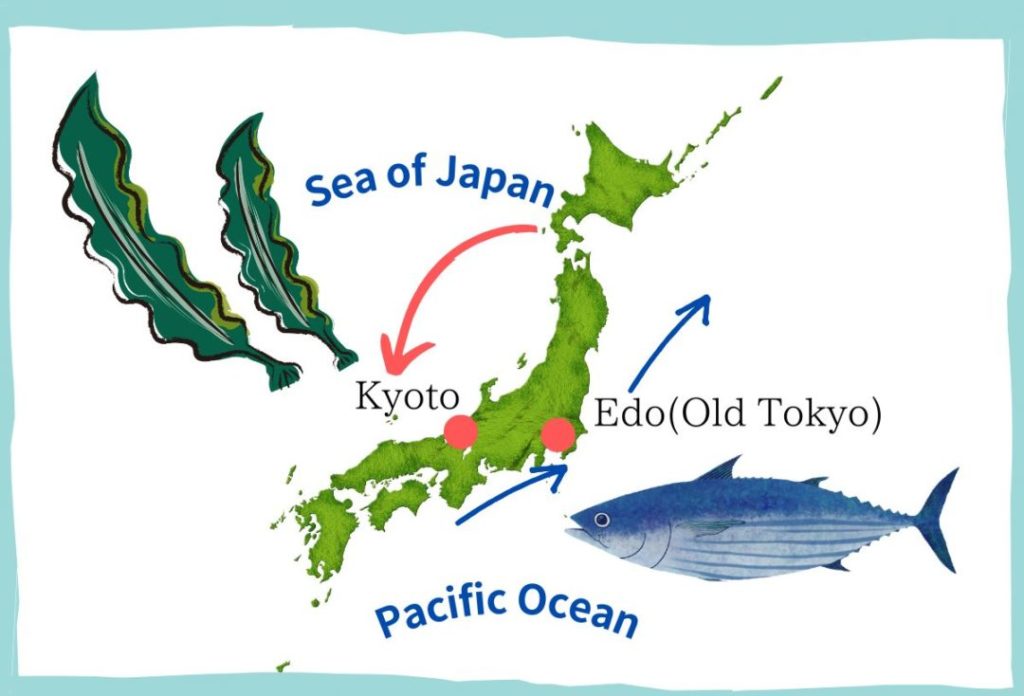
Bonito dashi and kelp dashi are used in a wide range of dishes. In the Kanto region, centering on Edo (old Tokyo), bonito dashi was developed, while in the Kansai region, centering on Kyoto, kelp dashi was developed.
In Edo, bonito was caught along the coast of the Pacific Ocean. On the other hand, the kelp used in Kyoto was harvested in Hokkaido (Northern island), brought to Fukui via the Sea of Japan on the “Kitamae bune”, a trading ship, and then transported overland to Kyoto. They were used to extract dashi to form the unique cuisine of each region.
In the Kanto region where people eat a lot of strong-flavored red-fleshed fish such as bonito, dishes using bonito dashi with a distinct flavor and dark soy sauce were developed.
On the other hand, in the Kansai region where people eat a lot of white-fleshed fish such as sea bream from the inland sea, the cuisine with kelp dashi and light soy sauce, which go well with light white-fleshed fish, became the mainstream.
More Deep Stories
Shellfish Dashi
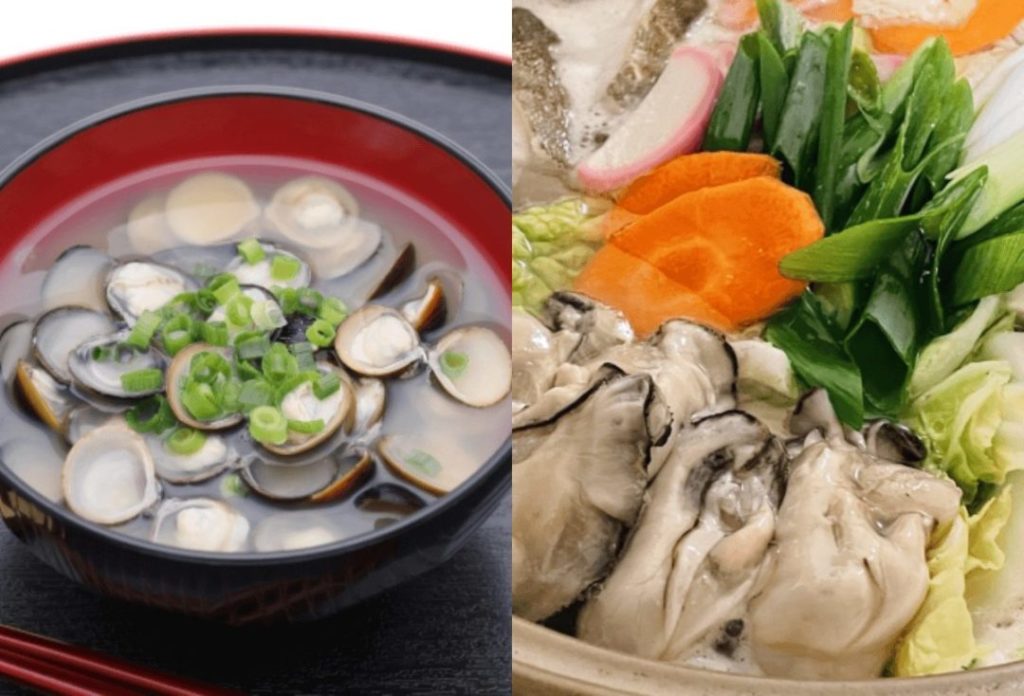
Bonito dashi, kelp dashi, and shiitake mushroom dashi are the most common dashi used in washoku (Japanese Cuisine) and are widely used as a base for dishes, but one should not forget about shellfish dashi.
Rather than being used as a base for cooking, shellfish dashi is used in soups and nabe (hot pot), where the flavor of the shellfish itself can be enjoyed. Steamed clams with sake, freshwater clam soup, and oyster nabe immediately come to mind.
Succinic acid is the base of the umami substance of shellfish dashi. It is with a strong umami taste characterized by sourness and astringency. It is rarely used in awase dashi (combination dashi) like bonito dashi or kelp dashi. It is possible to quickly produce a complex and rich flavor without spending a lot of time to boil.
Dashi for Ramen Soup
One would think that dashi is used only in traditional Japanese cuisine, but in fact it is also used in ramen, Japan’s national dish. There are Japanese-style tonkotsu (pork bone soup) ramen, in which you can enjoy both the umami of pork and bonito dashi, ramen with seafood soup packed with the umami of a variety of seafood and bonito dashi, and soy sauce soup ramen with a light yet deep flavor by combining chicken soup and bonito dashi.
Recently, ramen soup made with ago dashi have also become popular. Ago dashi is a high-grade dashi extracted from flying fish, which has a unique sweetness without the distinctive fishy smell, and ramen restaurants serving ago dashi ramen are getting popularity.
For more information about ramen, please check it from here: “8 Japanese Foods to Learn About” / “Ramen”
Dashi for Nabe
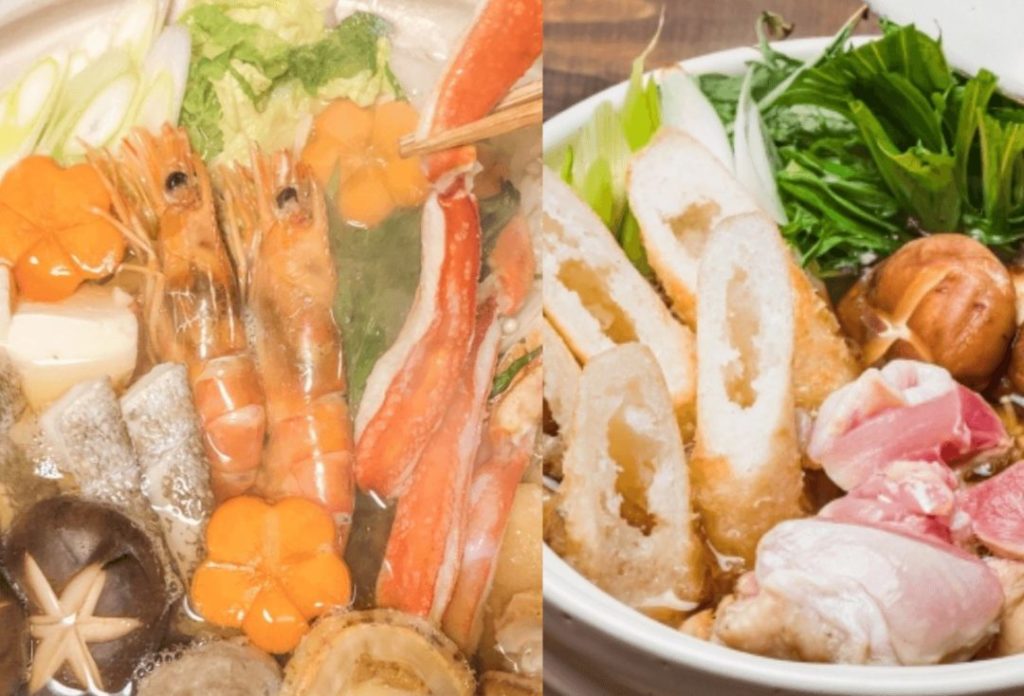
It is interesting to consider dashi for nabe (hot pot). One of the most popular seasonal dishes in winter in Japan is nabe. In a soy sauce based or salt based soup with bonito or kelp dashi, chicken, cod, salmon, shrimp, crab, oysters, and various other seafood and vegetables are added, simmered, and enjoyed with family or friends.
Japanese nabe has a wide variety of ingredients, and ingredients are added one after another as you eat. In this way, on top of the bonito and kelp dashi originally contained in the soup, umami from the chicken, seafood, and vegetables etc. dissolve into the soup. In this way, an extremely complex soup with a deep, rich flavor is created. Inosinic acid, glutamic acid, guanylic acid, succinic acid etc. get mixed together to create a multiple performance of umami.
After the ingredients in the pot are finished, rice is added and simmered again to produce a superb zosui (rice porridge), in which the grains of rice are soaked with umami. Many Japanese call this zosui “shime”(closing) and look forward to it when eating nabe.
Raw Egg over Rice — Tamago Kake Gohan (TKG)

Features
Rice with a raw egg is the soul food of Japanese people

Japanese people love to eat rice with a raw egg called Tamago Kake Gohan (TKG). “Tamago” means egg, “Kake” means to pour, and “Gohan” means cooked rice.
Pour the raw egg and soy sauce over the cooked hot rice and stir it!. The savory flavors of the egg and soy sauce are mixed with the grains of rice and stirred into the rice. I love the softness of the egg coated rice grains and the way it goes down my throat.
The synergistic effect of umami (pleasant savory taste) coming from both animal protein of the egg and the vegetable protein of the soy sauce stimulates the taste buds. It is a simple, easy-to-prepare, but blissfully enjoyable soul food for the Japanese.
The “raw food culture” represented by sushi and sashimi is a unique Japanese culture unparalleled anywhere in the world, and TKG is a typical example.
For more information about sushi, please check it from here: “8 Japanese Foods to Learn About” / “Sushi”
Why are eggs able to be eaten raw in Japan?
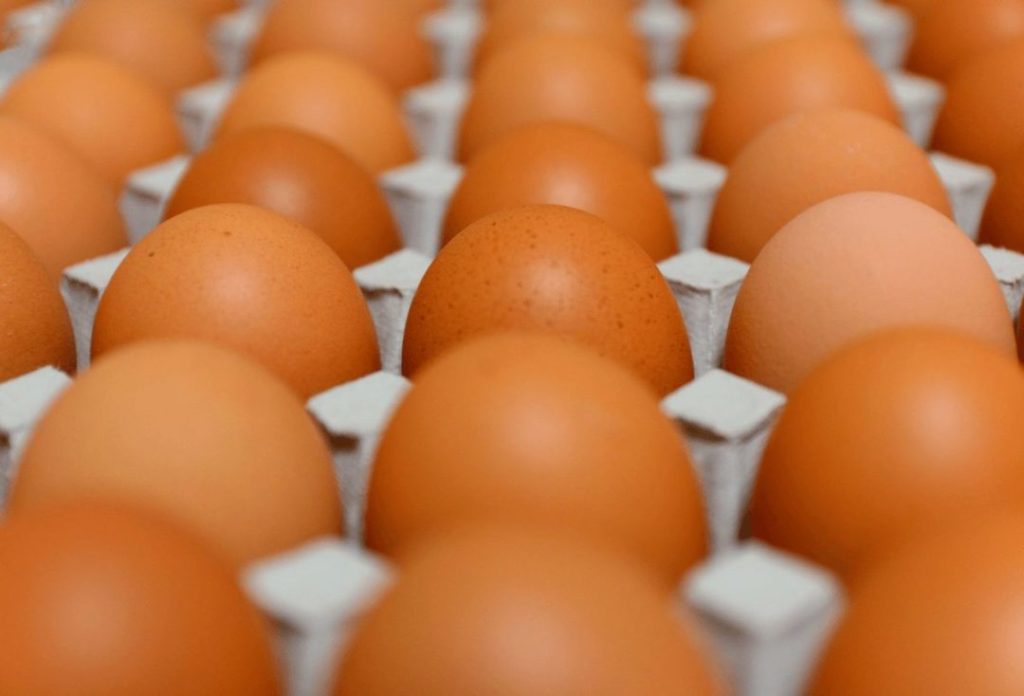
It is generally accepted around the world that eggs cannot be eaten raw because of the salmonella bacteria on the surface of the eggshell. The culture to eat eggs raw is received with considerable surprise.
Then why are eggs able to be eaten raw in Japan? In Japan, there is a well-established egg production, management, and transportation system designed to ensure that eggs are eaten raw.
Eggs laid by the parent birds are automatically collected by conveyor belts, placed in an egg washing and sorting machine without manual handling, the shells (outside of the eggs) are washed and sterilized with disinfectant solution, cracks and blood are automatically removed, and the eggs are sorted and packed according to their weight.
In addition, antibiotics are administered at the poultry farm to prevent the parent hens from contracting salmonella. The eggs are delivered in chilled temperature zones (below 10 Celsius or 50 Fahrenheit), and the expiration date is set based on the premise that the eggs are to be eaten raw.
More Deep Stories
Soy Sauce Specially for Egg on Rice
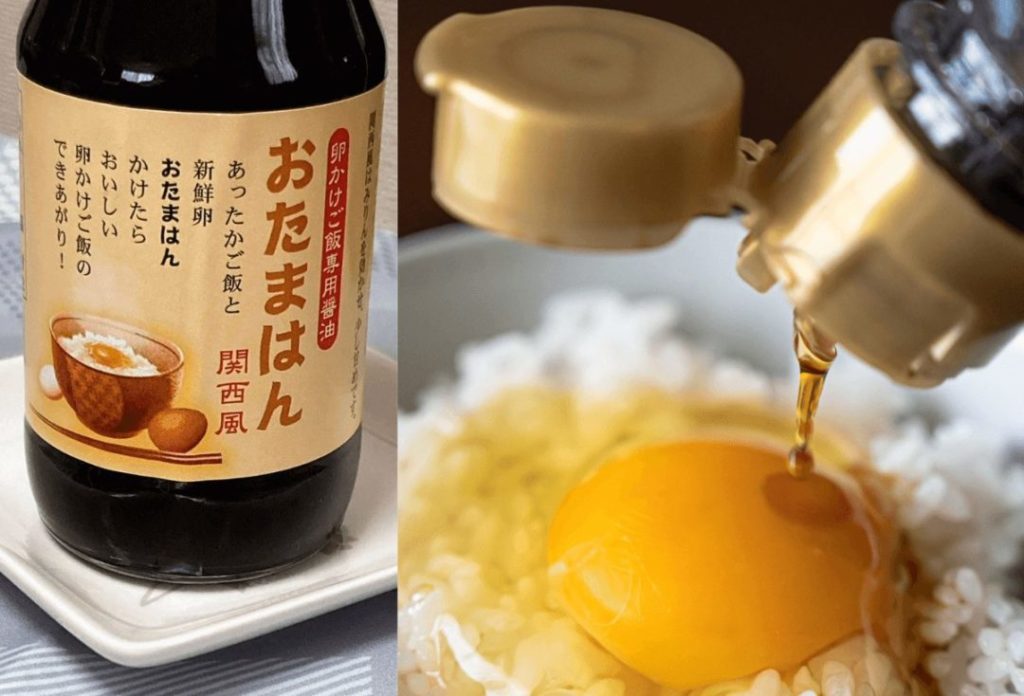
One example of the Japanese people’s deep attachment to TKG is the “special soy sauce for TKG”. Go to any supermarket or department store and you will find some soy sauce specially made for TKG.
Soy sauce plus dashi (Japanese soup stock) is the basis of the flavor. Some have the soy sauce flavor at the forefront, allowing to enjoy combined rich flavors of the soy sauce and egg, while others have less soy sauce, allowing to enjoy balanced taste of the egg and rice.
In addition, a variety of dashi are used, such as bonito, kelp, and others. Some dashi are made by a combination of several kinds of dashi. Each has its own flavor and aroma. There are even high-end soy sauces that contain truffles and sea urchins.
Raw Egg Variations
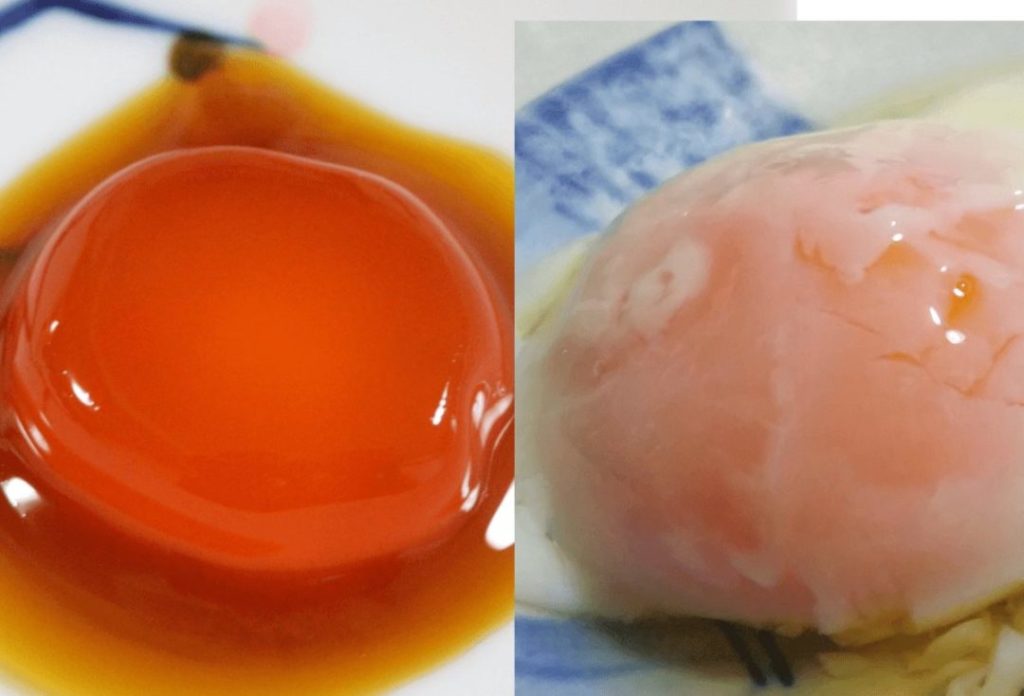
There is also a type of egg for TKG, that is a egg yolk marinated in soy sauce which is rich in taste compared to a raw egg. The yolk is made by taking only the yolk from a raw egg and soaking it in soy sauce. Recently yolks are more easily separated by freezing the eggs in their shells and then thawing them in many cases.
Half-boiled egg, so called “Onsen tamago” over TKG is also available. The name onsen tamago comes from the fact that the tamago (egg) was cooked at onsen (hot spring) using the heat from the hot springs. The yolk is boiled so that the egg yolk is semi-cooked and the egg white is semi-coagulated, making the egg white softer than the egg yolk. When one puts one’s chopsticks into the yolk, the thin skin breaks and the semi-cooked yolk inside flows out.
Whether you use soy-sauce marinated egg yolks or onsen tamago, you can enjoy the flavor and richness of the egg yolk more than with ordinary egg rice.
Raw egg is not only used for rice with egg — Japanese people’s attachment to raw eggs
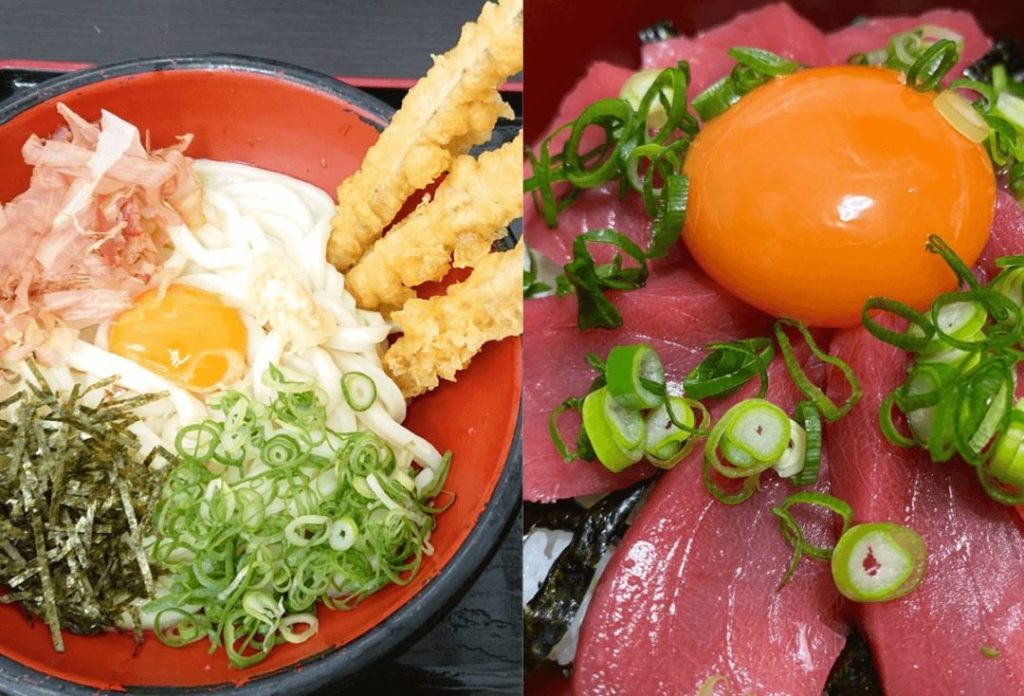
Japanese people have a deep attachment to raw eggs. Apart from being used as a dipping sauce for sukiyaki (thinly sliced beef cooked in an iron pot), raw egg is also commonly used as a topping for various other dishes. A typical example is topping for udon (thick Japanese wheat noodles) with raw egg and seafood rice bowl with raw egg or bowl of rice with seafood. It is also delicious on chilled tofu (soybean curd).
The egg is a magical ingredient that gently envelops the ingredients, mellows out the flavors of the seasonings, and adds a sticky, delicious flavor. The bright yellow color of the egg yolk combined with the green color of the green onions and perilla is beautiful to look at and appetizing.
Sukiyaki & Shabu-shabu
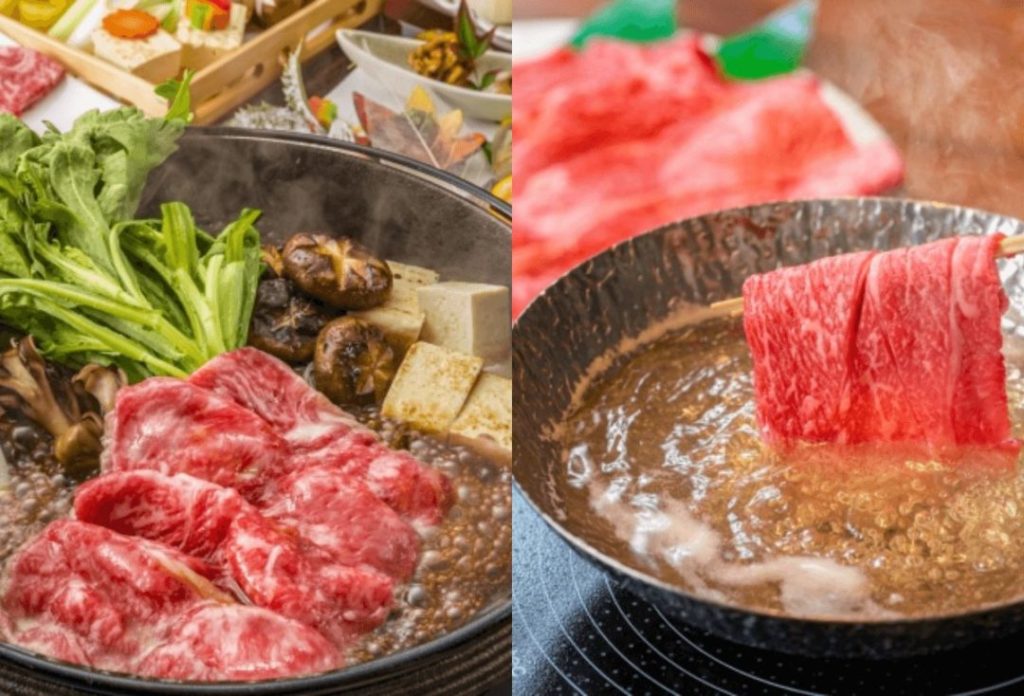
History & Features of Sukiyaki

Sukiyaki is a typical Japanese dish known around the world. Thinly sliced beef is seasoned with soy sauce, sugar and sake etc., along with green onions and other vegetables, and dipped in beaten egg.
In fact, beef was not commonly eaten in Japan until the end of the Edo period. From the end of the Edo period to the Meiji period (in the late 19th century), when slaughterhouses for foreigners were established in Tokyo and Yokohama, ” Gyunabe” (beef hot pot) restaurants became popular in the Kanto region* and became a symbol of civilization and enlightenment.
Gyunabe at that time consisted of beef simmered in miso (soy bean paste) sauce, but this cooking style changed into one in which the beef and vegetables are simmered in an iron pot with “Warishita” (a seasoning liquid made of soy sauce, sake, sugar, and Japanese soup stock).
In the Kansai region**, on the other hand, there has long been a dish called sukiyaki, in which fish such as sea bream is simmered in a broth of soy sauce and sugar. In the Meiji period (in the late 19th century), the dish developed into Kansai-style sukiyaki, in which beef was used instead of fish, and the beef was grilled instead of simmered.
The Great Kanto Earthquake of 1923 damaged and closed many of Tokyo’s gyunabe restaurants, and then Kansai-style sukiyaki was introduced to the Kanto region and fused with gyunabe to create “Kanto style sukiyaki.
* Eastern part of Japan consists of Tokyo and the surrounding area **Western part of Japan consists of Osaka and the surrounding area

This led to a difference in the way sukiyaki is prepared in the Kanto and Kansai regions. In the Kanto region, first, boil warishita in a pot and simmer beef and vegetables together while, in the Kansai region, the beef is first grilled in a pot with beef fat, then seasoned with sugar and soy sauce, and the vegetables are added later, using the water from the vegetables to simmer them.
Where did the name “Sukiyaki” come from, anyway? There are two theories as to its origin: one is “Sugiyaki” from the early Edo period (in the early 17th century).” Sugi” is cedar and “Yaki” is to grill. Sugiyaki is a dish in which seafood such as sea bream and vegetables are placed in a box made of cedar wood and cooked in miso (soy bean paste).
The other, from the late Edo period (in the late 19th century), is “Sukiyaki”. “Suki” is plow or spade, a farm tool, and “Yaki” is to grill. Sukiyaki is a dish in which chicken, seafood, and other items are cooked over a fire using a plow or spade.
History & Features of Shabu-shabu

Shabu-shabu is a Japanese beef dish that should not be forgotten. Very thin slices of beef are quickly dipped into a pot of boiling broth, and then dipped into ponzu (Japanese sauce made of soy sauce and citrus juice) or sesame sauce.
The meat for shabu-shabu is sliced very thinly, so it is cooked quickly and does not become tough. The meat is cooked while swimming in the broth in a short time without removed from chopsticks.
There is a theory that the origin of shabu-shabu is a Chinese hotpot dish called “Hinabe”. This is because hinabe is similar to Japanese shabu-shabu, except that hinabe uses mutton. It is also said that the hotpot with a vent hole in the center used for hinabe is the prototype for today’s shabushabu hotpot.
On the other hand, there is another theory that“Mizutaki” is the origin of shabu-shabu. “Mizu” is water and “Taki” is to simmer. In the Kansai region, a dish similar to shabu-shabu has existed since long ago, in which unseasoned meat and vegetables are simmered in a kombu (kelp) broth.
As for the name “shabu-shabu,” Suehiro, an old restaurant in Osaka invented and introduced it as menu item in 1952, and later registered it with the trademark “Suehiro’s Shabu Shabu” and “Meat Shabu Shabu.
The owner of the restaurant named the dish “shabu-shabu” inspired by the sound of the water, which was made when the staff rinsed their hand towels used in the restaurant in a tub, which resembled the way beef is dipped in broth.
More Deep Stories
Wagyu
Wagyu — Japanese people are particular about beef
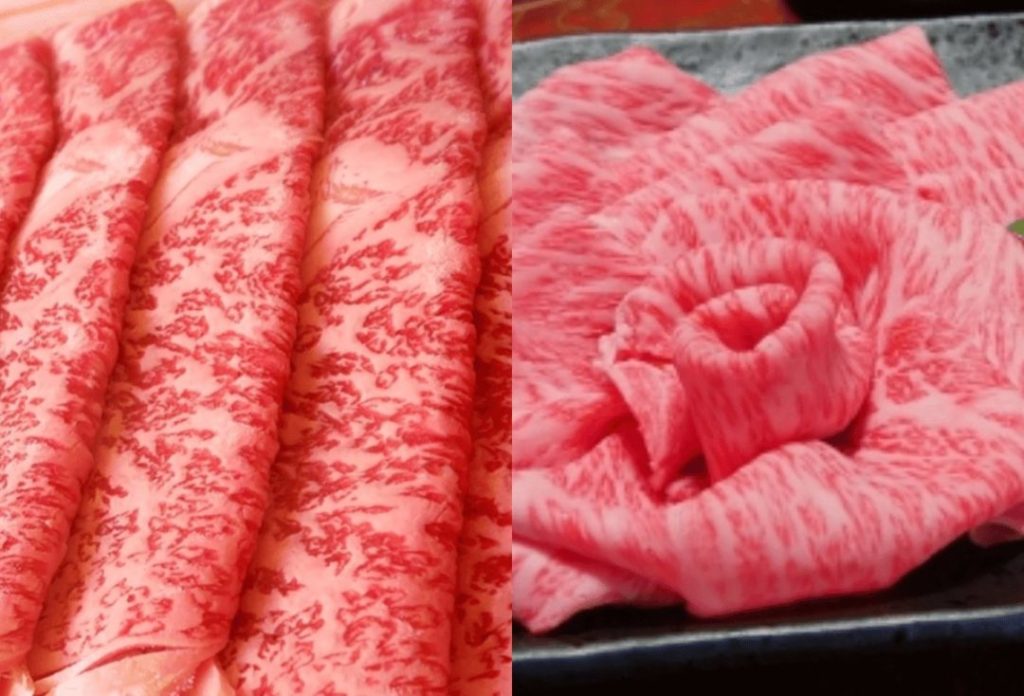
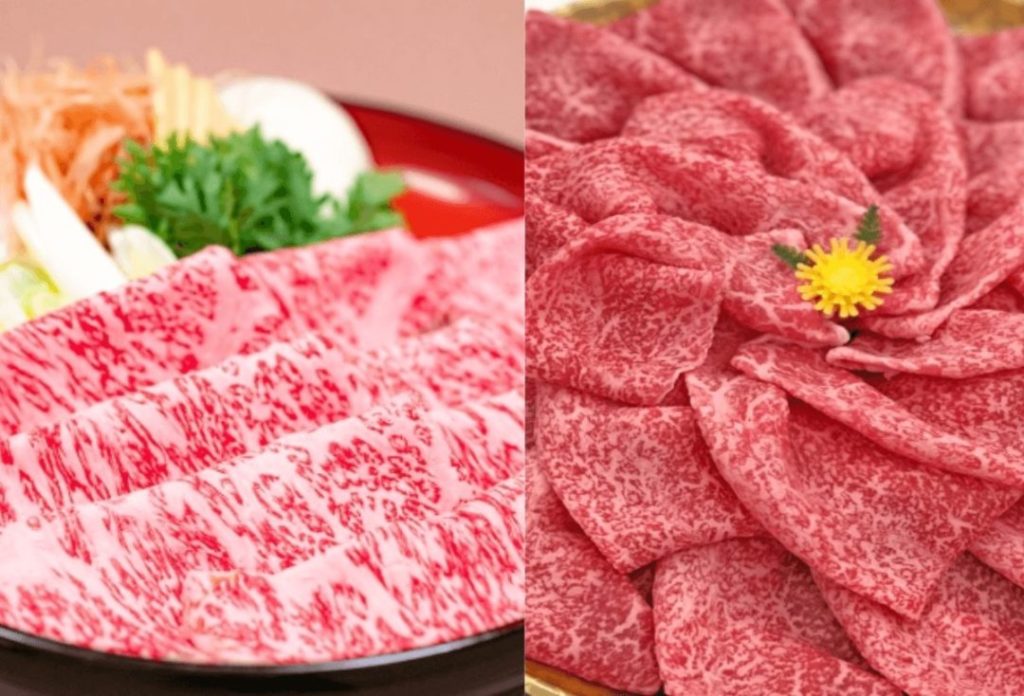
There are various brands of “Wagyu” in Japan. Wagyu is a breed of beef that has been bred from foreign breeds which came from abroad after the Meiji period (after the late 19th century), and native breeds to improve its quality to suit Japanese tastes.
Wagyu has a sweet fatty aroma called “wagyu kou”(aroma of wagyu). It is created when a thin layer of fat called “Sashi” is inserted between the lean meat. Meat with beautiful sashi looks tasty. Such meat is called “Shimofuriniku” (marbled meat).
When actually eaten, it has a melt-in-your-mouth texture. The flavor of the lean part, which contains amino acids that create umami (pleasant savory taste), the aroma of the fat, and the melt-in-your-mouth texture are the requirements for good Wagyu.
Representative wagyu brands include “Matsusaka Beef” (Mie Prefecture), “Yonezawa Beef” (Yamagata Prefecture), “Hida Beef “(Gifu Prefecture), “Omi Beef” (Shiga Prefecture), and “Tajima” Beef (Hyogo Prefecture), which are named after the land in which they are raised.
The world-famous “Kobe Beef” is branded among Tajima Beef from Hyogo Prefecture, where the city of Kobe is located, that meets certain standards.
Wagyu is also popular overseas, but its exported parts vary from region to region. In Asia, where people eat thin slices of beef as well, a whole cow’s worth of beef is exported, but in Europe and the United States, where demand for steaks is high, high-end parts such as sirloin make up most exports.
Meat for Sukiyaki and Shabu-Shabu
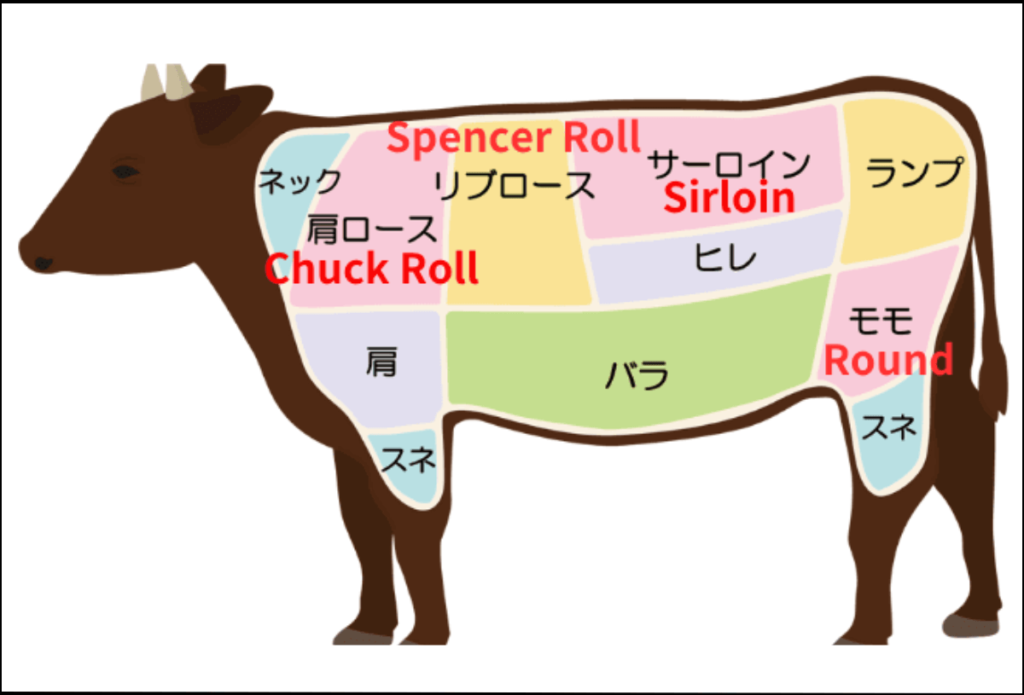

Sukiyaki is a dish in which beef is simmered or grilled, while shabu-shabu is a dish in which beef is quickly cooked in broth. The thickness of beef for sukiyaki is about 1.8 mm to 2.5 mm, while that for shabu-shabu is about 1.5 mm to 2.0 mm (sometimes about 1 mm).
In sukiyaki, beef is simmered or grilled, and therefore the meat needs to have a certain thickness to withstand the cooking. It needs to be thin enough to allow the meat to cook through before it becomes tough, but needs to be thicker and more tender than shabu-shabu, which requires a slightly higher fat content, such as sirloin, chuck roll, and spencer roll.
Shabu-shabu, on the other hand, tastes good with chuck roll, but if you prefer a lighter flavor, round is also recommended. In short, it is a matter of individual preference.
Sukiyaki with Beaten Egg
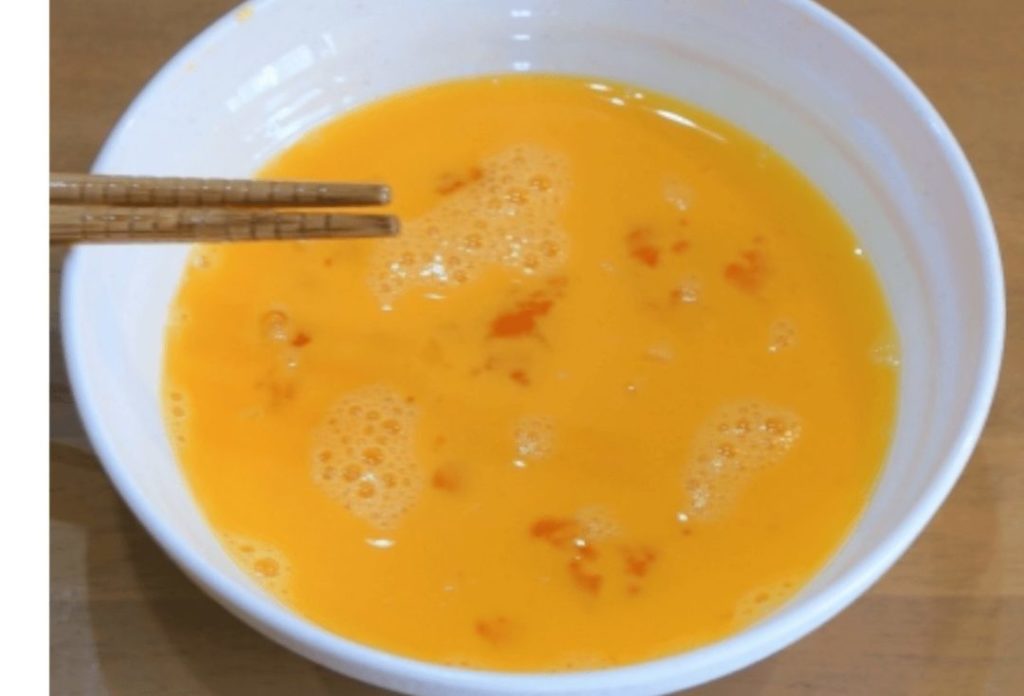
It is common to eat sukiyaki with a beaten egg. What is the reason for this? It is said that the practice of dipping a hot sukiyaki in beaten egg began as a way to avoid burns when eating sukiyaki.
Of course, another major reason is that the egg mellows out the flavor of the sukiyaki. The strong flavors of sugar and soy sauce fuse with the delicious taste of the eggs to create a sticky, rich, mellow flavor.
There is also a theory that this was to eliminate the smell of beef, which Japanese people were not accustomed to in those days.
Sukiyaki with Red Wine — Soy sauce, sugar and red wine go well together!
Adding red wine to warishita gives sukiyaki a fruity flavor, which softens its heavy flavor and makes the sukiyaki lighter. It also good with Western-style ingredients. Tomatoes can be added, and mushrooms can be used instead of shiitake mushrooms for instance.
Yaki-shabu — Pursue delicious and healthy meat dish

Yaki-shabu (grilled shabu-shabu) is a recent trend. The meat is sliced thinly for shabu-shabu and quickly grilled on a griddle. As with regular shabu-shabu, the meat is not removed from the chopsticks, and quickly grilled on both sides on the hot griddle. The excess fat dissolves and is removed and the surface becomes crispy.
If you wrap shredded vegetables with the grilled beef, you can eat both meat and vegetables at the same time, which is very healthy. It is also recommended to eat it lightly with salt or wasabi (Japanese horseradish), as well as with ponzu (Japanese sauce made of soy sauce and citrus juice) or sesame sauce, like regular shabu-shabu. There are also restaurants specializing in yaki-shabu.
Okonomiyaki & Takoyaki

History & Features of Okonomiyaki
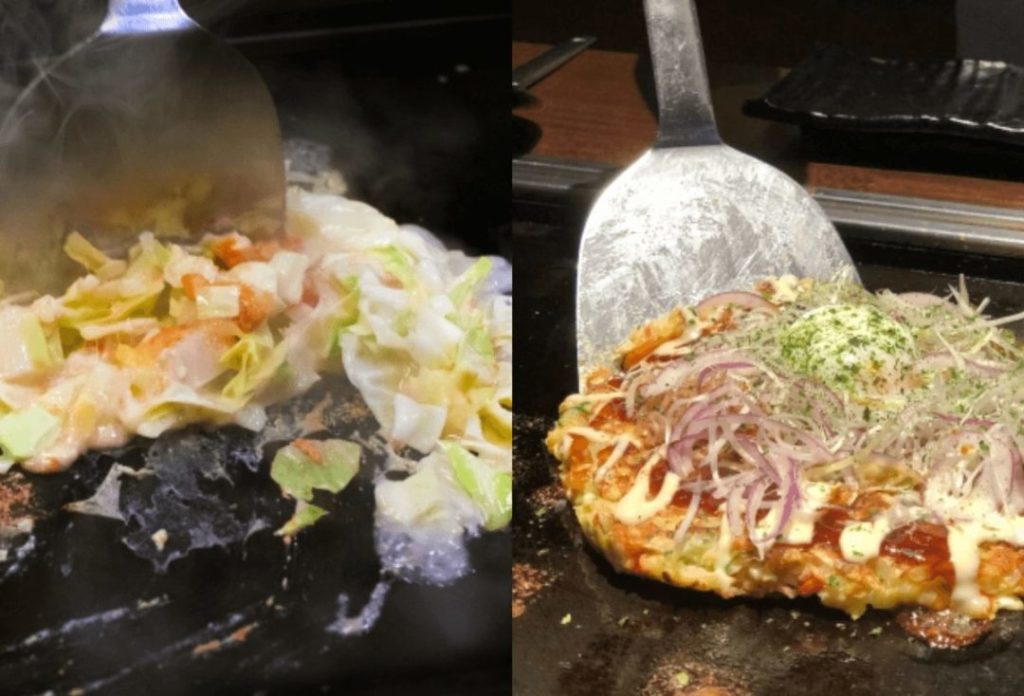
The origin of “Okonomiyaki” * is said to be “Funoyaki” served as a tea ceremony snack by Sen no Rikyu, a famous tea ceremony master, in the Azuchi-Momoyama period (in the 16th century). The dough was made by kneading flour with water and sake, spreading it thin, baking it, spreading miso on it, and rolling it into a ball.
Later, in the Meiji period (in the late 19th century), “Monjayaki” appeared in Tokyo. Like today’s okonomiyaki, vegetables were used and it was served as a snack for children.
In the Taisho period (in the early 20th century), minced meat, beef tendon and chopped konjac (yam cake) etc. were added to the dough in the Kansai region (the western Japan area around Osaka and Kyoto) and it was coated with Worcestershire sauce.
The Worcestershire sauce was not yet common in Japan at that time, thus it was called “Yoshokuyaki” (Western-style grilled snack). It eventually spread from the Kansai to the rest of Japan. Yoshokuyaki was sold at 1 sen (one-hundredth of a yen) apiece at the time, and was called “1 sen Yoshoku”. It is said that this yoshokuyaki became the original form for today’s okonomiyaki.
The oldest existing okonomiyaki restaurant is said to be “Sometaro” in Asakusa, Tokyo. Okonomiyaki is now one of Japan’s most popular casual gourmet foods, and is also very popular overseas.
*”Okonomi” means “by your favorite way” and “Yaki” means ”to cook” on a griddle.

The two mainstays of okonomiyaki are “Kansai-style okonomiyaki” from Osaka and “Hiroshima-style okonomiyaki” from Hiroshima.
Kansai-style okonomiyaki is made from the batter of flour with water, grated yam, and eggs, mixed with cabbage, tenkasu (deep fried dough), red ginger, and other ingredients. Toppings such as thin-sliced pork may be cooked first and then covered with the batter, or they may be placed on top of the batter and flipped over to cook . In either case, the okonomiyaki is soft and fluffy like a pancake.
Hiroshima-style okonomiyaki is made by spreading a thin layer of batter on a griddle and cooking it, then piling up cabbage, bean sprouts, squid tempura, thin-sliced pork, etc. on top, and then flipping it over to steam it.
Next to it, Chinese noodles are stir fried to make yakisoba (Chinese stir fried noodles). Then, place the okonomiyaki on top of the yakisoba, with cabbage side down.
Crack an egg onto the griddle and cook it in a circular shape while breaking up the yolk and mixing it with the white. Place the okonomiyaki on top, with the yakisoba on the bottom.
Then, turn the okonomiyaki over and cook it again. (From the top, the order is egg, yakisoba, cabbage, and grilled dough) This dish is tall and hearty.
In the Hiroshima style, Chinese noodles are an essential ingredient, but in the Kansai style, Chinese noodles are usually not used. Kansai-style okonomiyaki has a version with Chinese noodles as well, which is called “Modernyaki” to distinguish it from regular okonomiyaki.
Both Kansai-style and Hiroshima-style okonomiyaki are finished with sauce. Nowadays, mayonnaise is often added on top of the sauce.
History & Features of Takoyaki
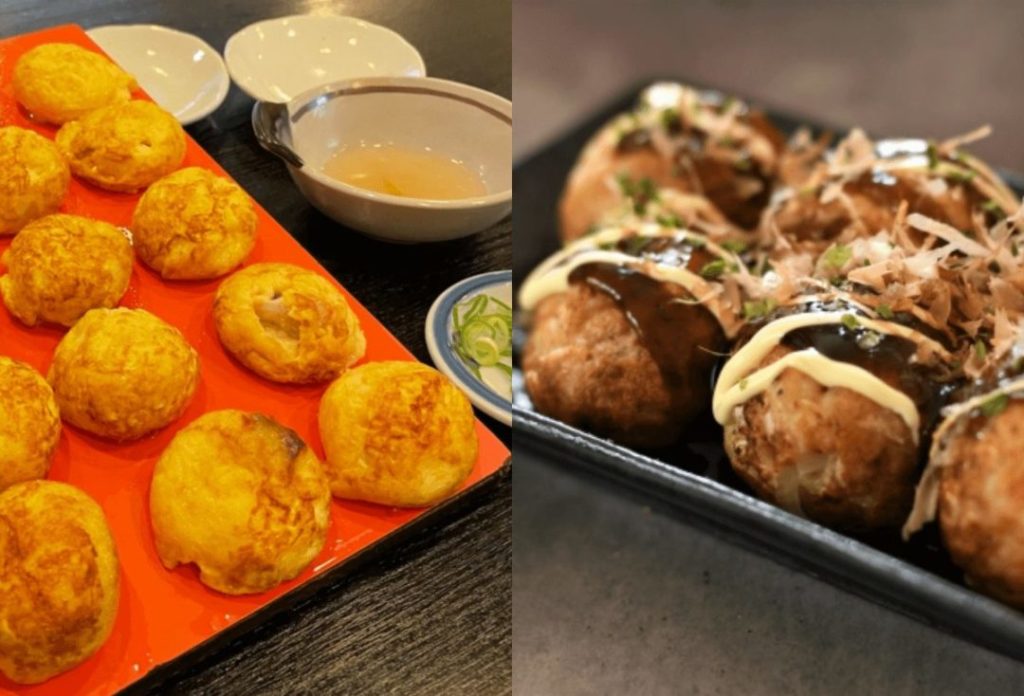
One of the roots of “Takoyaki” is “Akashiyaki”. Akashiyaki is a local dish that originated in Akashi during the Edo and Meiji periods (in the Late 19th century). The reason for this is probably because there were plenty of tako (octopus) caught in Akashi. It is made with the dough of beaten egg, flour, and starch as well as chopped octopus, and eaten with dashi (Japanese soup stock).
The second root is “Radioyaki,” which appeared in Osaka. It was made by dissolving flour in dashi(Japanese soup stock) and cooking rounds with meat, beef tendon and chopped konjac (yam cake), etc. It was a new food at the time, so it was called “Haikarayaki”.* As it was a new food with modern image, it was named after the word “radio,” which at the time was a representative of a high-caliber, high-end product.
In 1935, Aizuya in Osaka is said to have been inspired by a customer’s comment, “In Akashi, they put octopus in their akashiyaki,” and launched a version of radioyaki with octopus as takoyaki.
After World War II, takoyaki began to be served with sauce, imitating yoshokuyaki. These days, it is very popular overseas as well as okonomiyaki and is also known as “Samurai balls”.
*Haikara is said to come from “high collar” of formal dress of male in the Meiji period which represents something modern or fashionable.

Takoyaki is made in a takoyaki cooker with semicircular holes. Dough is poured into the holes, and then chopped octopus, green onions, red ginger, and other ingredients are added. Then, the dough that spilling out of the holes is inserted into the holes using a skewer. After a little while, the dough around the edge of the holes will puff up.
Then it is the time to make takoyaki into a round shape, which requires a bit of skill. Insert a skewer from the side of the holes and turn the takoyaki 90 degrees. If the takoyaki does not turn well, it is not cooked enough.
After cooking the takoyaki for a while, turn it 90 degrees again, and then push the dough that has come out of the holes into the holes, and turn it again and again to cook it. In this way, the takoyaki becomes round and evenly cooked inside.
More Deep Stories
Takoyaki Parties
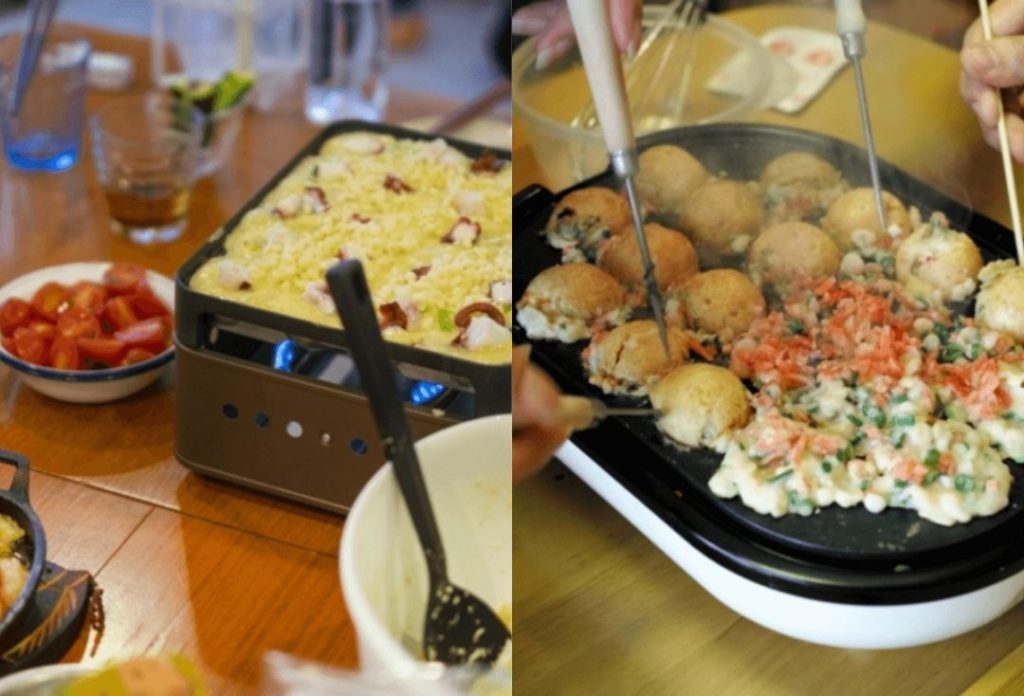
Takoyaki parties,”takopa” for short, at home has become popular. It is held as a family meal or a party with friends, and is enjoyed in a lively atmosphere. A takoyaki cooker is necessary for a takopa. Recently, many people buy takoyaki cookers for takopas. In Osaka, the birthplace of takoyaki, it is said that every house has a takoyaki cooker.
The difference takoyaki in takopas from ones in restaurants or food stalls is the variation of ingredients. Not only the basic ingredients such as octopus, green onions, and red ginger, but all sorts of ingredients are enjoyed. Recently, there are even dessert takoyaki.
Some people even brag to their friends about their skill at cooking takoyaki. Some of them have mastered the technique of takoyaki that is like a professional.
Sauce and Mayonnaise
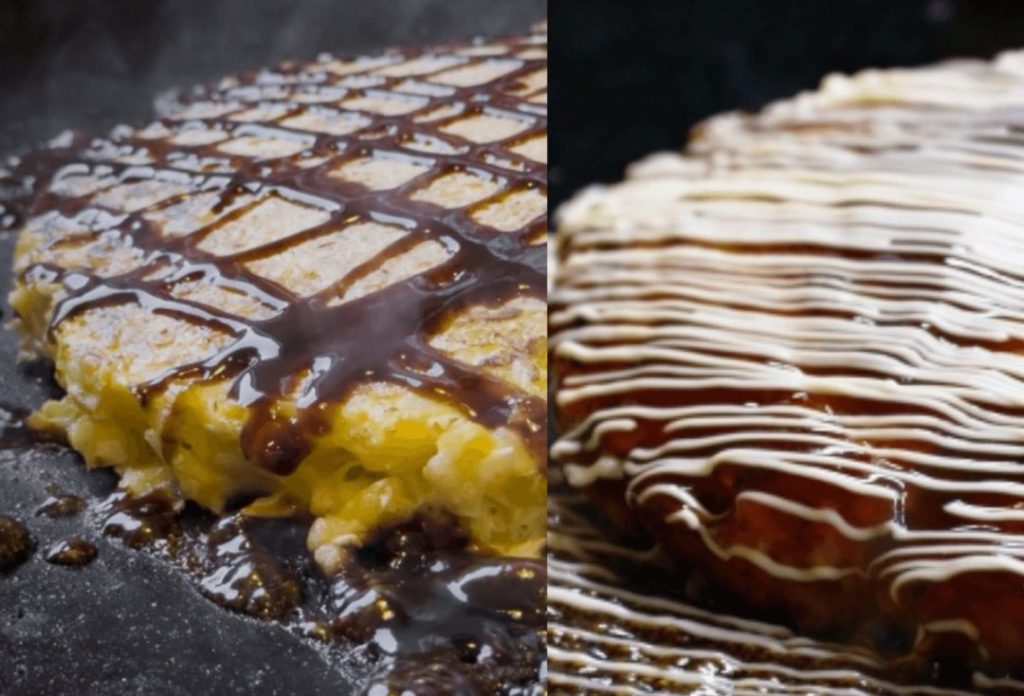
One of the secrets of the popularity of okonomiyaki and takoyaki overseas is said to be the taste of the sauce. Although the sauces used for okonomiyaki and takoyaki are not exactly the same, the rich, sweet and savory flavor seems to be favored.
In the West, there is Worcestershire sauce. It is made by adding vinegar and spices to vegetable and fruit juices, then seasoning with salt and sugar while aging.
On the other hand, okonomiyaki and takoyaki sauces are made from tomatoes, other vegetables and fruits with some 50 different ingredients, resulting in a thick, sloppy sauce with a rich sweet and savory taste.
Moreover mayonnaise plays an important role . The sourness of mayonnaise refreshes the fatty taste of okonomiyaki and takoyaki and the thick sauce. The emulsified creamy mayonnaise mixes go well with the thick sauce to create a unified flavor.
The savory flavor of the cooked flour, the delicious taste of seafood and vegetables such as meat and octopus, the rich sweet and savory flavor of the special sauce, and the sourness of the mayonnaise all come together to create the addictive taste of okonomiyaki and takoyaki.
Wagashi(Japanese Confectionery)
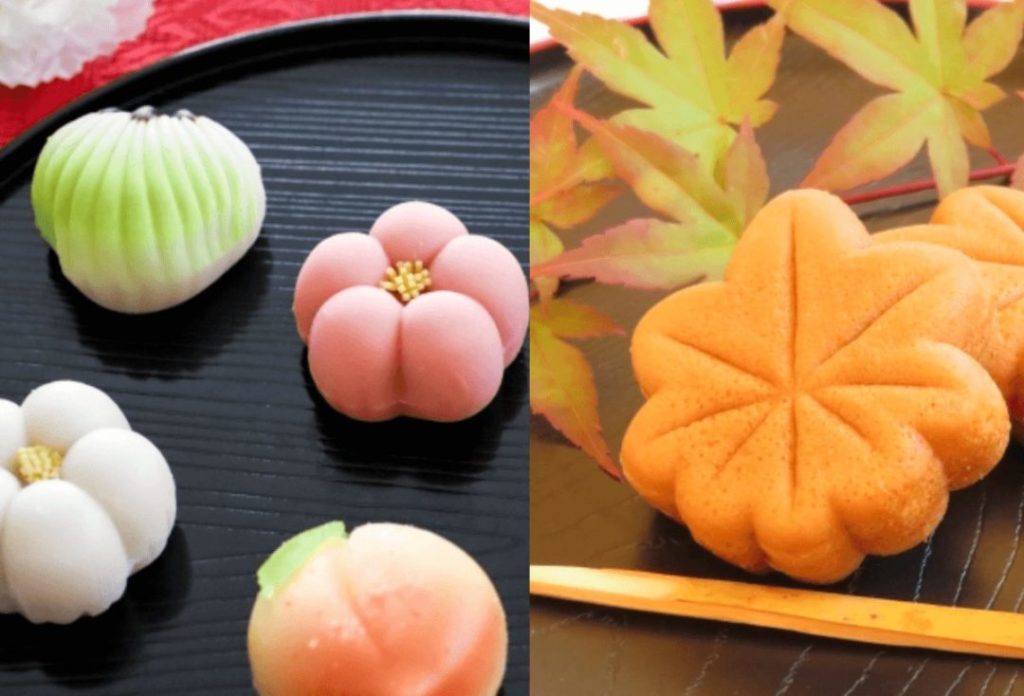
History

Nuts and fruits were called “Kudamono” in ancient times, and later written as “confectionery” in Chinese characters when the Chinese characters introduced in Japan. This is thought to be the origin of wagashi. Later, powdered nuts and rice were used to make rice dumplings etc.
In the Nara period (in the 6th century), Japanese missions to Tang (old capital of China) introduced “Karakudamono.” (Chinese confectionery) which is made from wheat or rice flour and fried in oil when returned to Japan.
After that in the Kamakura period (in the 12-13th century), monks who studied Buddhism and returned from China, introduced dim sum, a light meal served at Zen temples. One of the dim sum was said to be the original form of “Manju (red-bean-paste sweet bun)”, a typical Japanese confectionery.
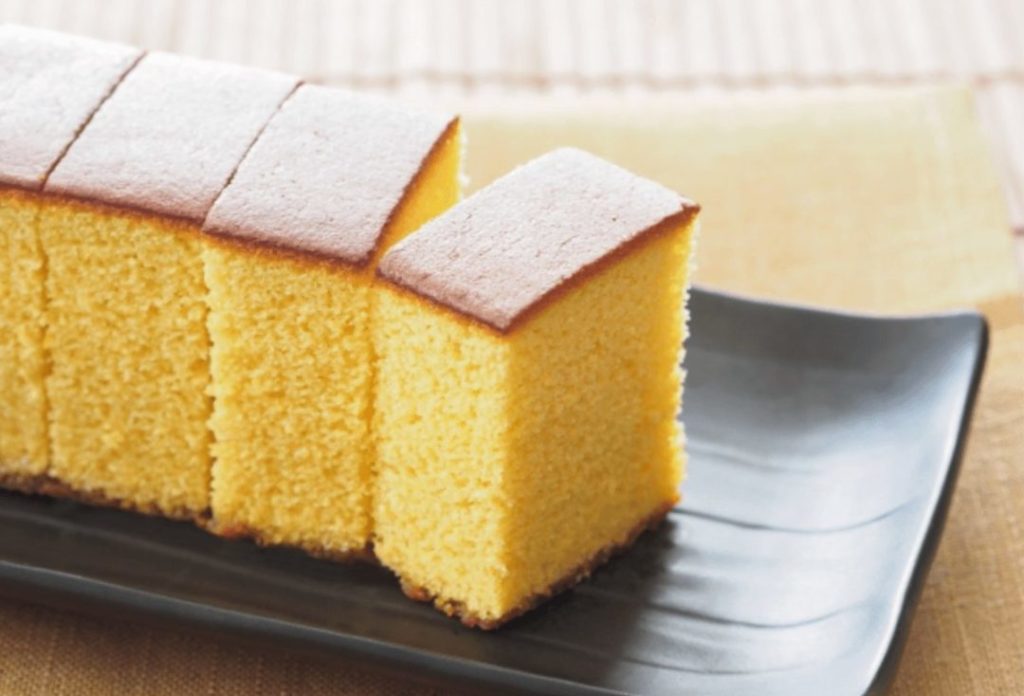
At the end of the Muromachi period (in the 13-16th century), Christian missionaries introduced Nanban(European) confectionery such as Castella etc. Nanban confectionery, which used sugar, which was precious at the time, and chicken eggs as their main ingredient, had a great influence on the development of Japanese confectionery.
During the Edo period (in the 17th -mid 19th century), when trading as well as people’s comings and goings was restricted and little foreign cultural influence was given, various types of wagashi were created mainly in Kyoto, where the ancient Japanese culture was deeply rooted, leading to the modern wagashi.
Features
Sakura-mochi
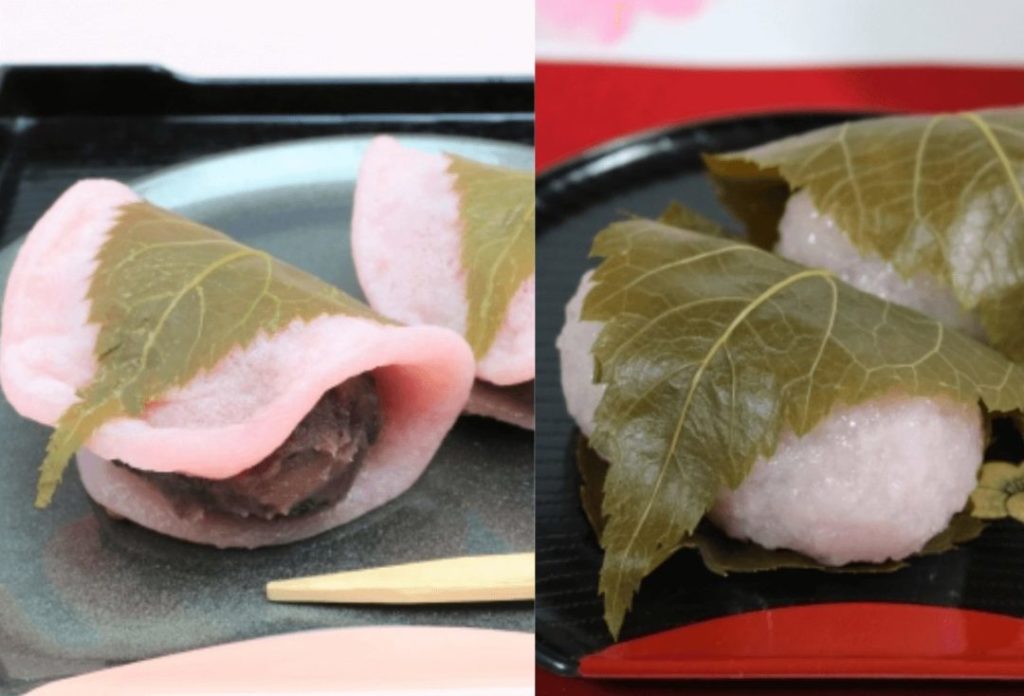
“Sakura-mochi” is a confectionery wrapped in salted cherry leaves which is associated with spring, and is an essential part of the Dolls’ Festival or Girls’ Festival (March 3rd, a festival to pray for the healthy growth and happiness of girls). In the Kanto* style, the red bean paste is rolled in a baked wheat flour dough, while in the Kansai** style, the dough is made from “Domyoji Flour” (glutinous rice that has been steamed, dried, and coarsely ground) which wraps red bean paste.
* Eastern part of Japan consists of Tokyo and the surrounding area **Western part of Japan consists of Osaka and the surrounding area
Taiyaki / Castella
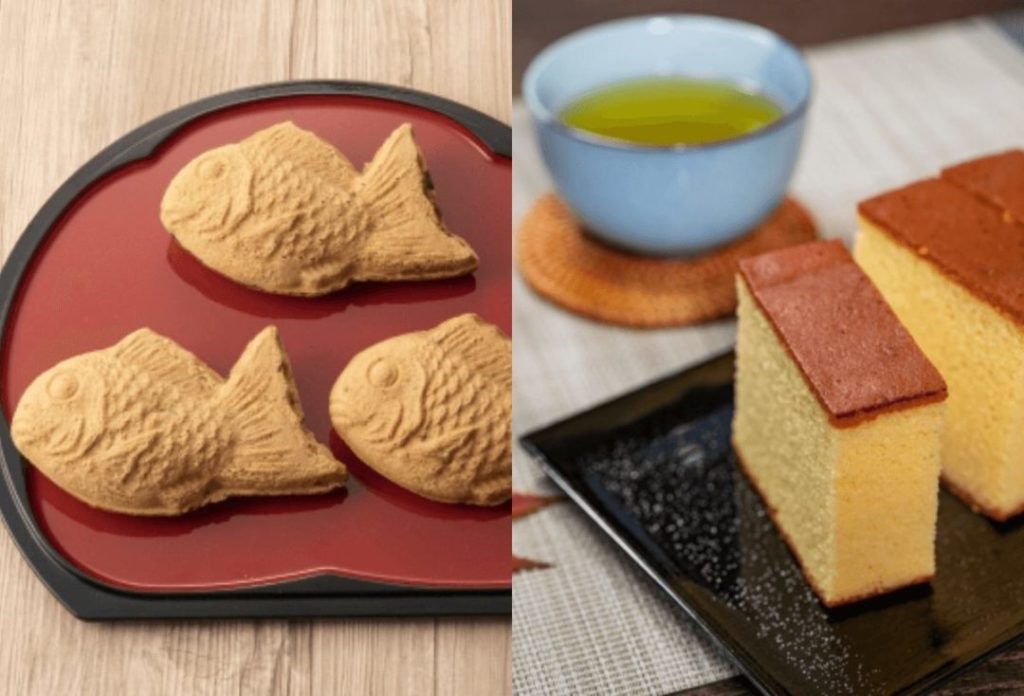
“Taiyaki” is a pastry made by baking a dough shaped like a sea bream and sandwiching red bean paste. The design of the sea bream varies from store to store. Some taiyaki are filled with custard cream or chocolate.
“Castella” has its roots in Portugal and Spain, but developed uniquely in Japan. It is baked in an oven and cut into rectangles. It is made with starch syrup and is characterized by its moist texture. It looks similar to Western sponge, but the texture is completely different.
Warabi-mochi / Yokan

“Warabi-mochi” is made from warabi flour (powdered starch from the root of the bracken plant) with characteristics of chewy texture and smoothness. Sometimes we add matcha (powdered green tea) to make. Since warabi flour is hard to obtain, other starches are often used in recent years. It is sprinkled with kinako (soybean flour) and served with molasses. Sometimes it is sprinkled with matcha instead of kinako.
“Yokan” is made by pouring red bean paste into a mold and hardening it with agar. Soft “Mizu-yokan”, with little agar, is a typical summer treat and is also used as a souvenir or gift. Steamed yokan is made by adding wheat flour or “Kudzu flour” (arrowroot starch) instead of agar, and steaming to harden. “Chestnut yokan” made with cut chestnuts is a popular type of yokan.
Monaka / Rakugan

Monaka” is made by dissolving “Shiratama flour” (glutinous rice flour) in water and baking it into wafers until crispy, then sandwiching bean paste between the wafers. The moisture content of the bean paste is kept low in order to maintain the crispy texture of the wafers. Some monaka are sold with the wafers and bean paste separated so that they can be sandwiched together when eaten. Like yokan, monaka is valued as souvenirs and gifts.
“Rakugan” is made by molding rice flour, syrup, sugar, etc. and drying it. They are formed in the shape of flowers of the four seasons like cherry blossoms, or traditional Japanese good luck charms such as cranes & turtles & sea breams, and pine & bamboo & plum trees. They are often used as dried confectionery at tea ceremonies (served with thin tea) or as offerings, etc. Since they are used for noble occasions, they are regarded as high-class Japanese confectionery.
Nerikiri / Botamochi
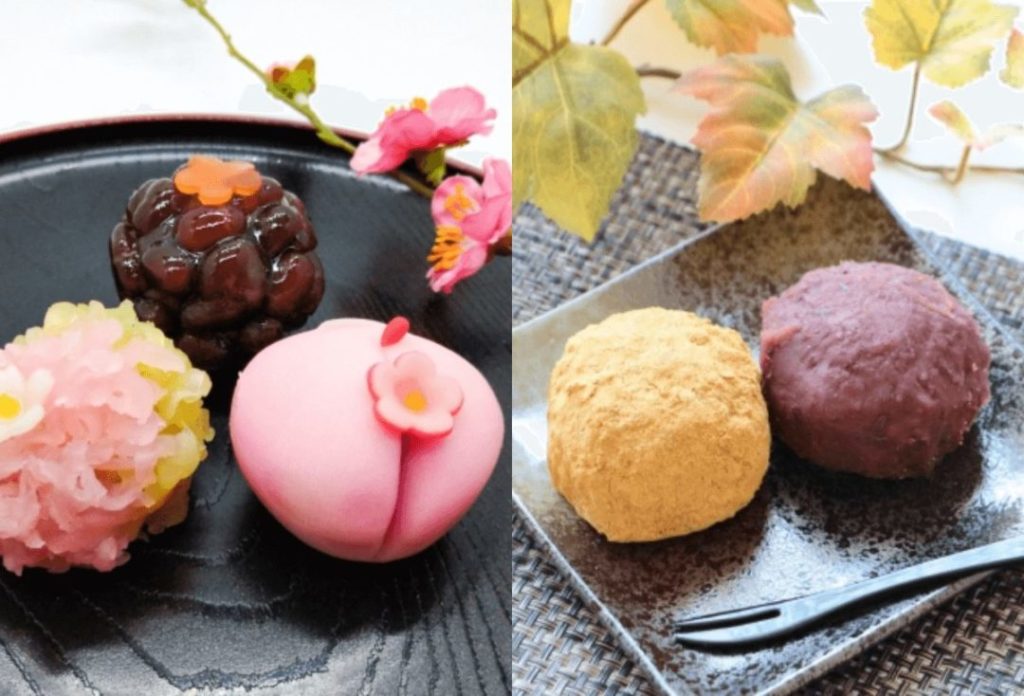
White bean paste is used to make “Nerikiri” as a main ingredient. Yams or Gyuhi (glutinous rice flour kneaded with sugar and water) is also used as a binder. Then they are kneaded together to make nerikiri. It is classified into two categories: “Jomono,” (high-class one) which is used as the main confectionery at tea ceremonies (served with thick tea) and as festive gifts, and “Namimono,” (regular-class one) which is used on other occasions. Nerikiri is made in the shape of seasonal plants and seasonal scenes which requires the sensitivity and skill of wagashi craftsmen.
“Botamochi” is made by cooking rice and glutinous rice, crushing the rice grains, shaping them into a round or bale shape, and covering it with red bean paste or soybean flour. Sometimes only glutinous rice is used. It is eaten in Ohigan (in the equinoctial week). In the old days, it was a popular treat for the common people, and was served to guests, celebrations, and community gatherings. It is also used as an offering at Buddhist memorial services as well.
Kashiwamochi / Hishimochi

To make “Kashiwamochi”, first wrap red bean paste in a rice cake, and then wrap it in oak leaves, and steaming it. It is eaten on the Dragon Boat Festival or Boy’s Festival to wish for the growth of boys, longevity, and prosperity of offspring. Some are made with miso bean paste instead of red bean paste. In most cases, rice is used instead of glutinous rice to make the mochi.
“Hishimochi” is a diamond-shaped confectionery associated with the Dolls’ Festival or Girls’ Festival. It is decorated to wish for the growth of girls, longevity, and prosperity of offspring. The pink mochi (rice cake) represents peach blossoms, the white one remaining snow, and the green one young grass.
More Deep Stories
Express the four seasons with Wagashi
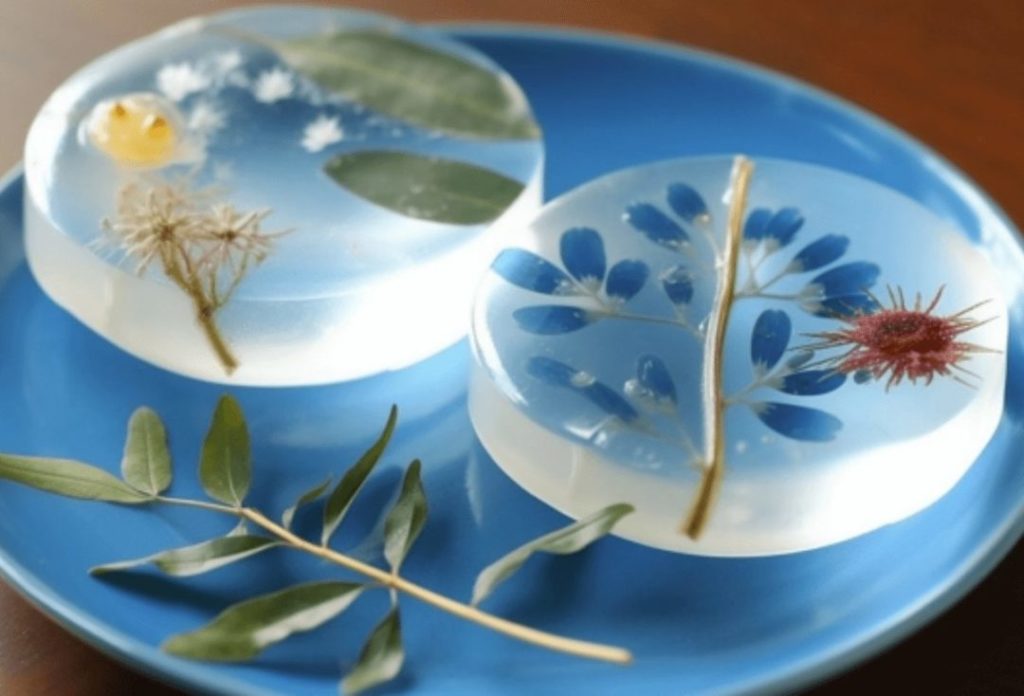
Japan is not the only country with four seasons, but in Japan, the seasons, food, and events are closely linked. Japan has a calendar called Nijushisekki, which divides each of the four seasons into six (it means to divide a year into 24 divisions).
The first day of spring and autumnal equinox day are the typical examples. TV news also reports which of the 24 seasonal divisions today falls on. Many wagashi express these changing seasons through their shapes, colors, and ingredients. The culture to select and present wagashi appropriate for the season, and to eat wagashi together at gatherings has deeply taken root in the Japanese society.
Daily Life and Wagashi

Wagashi is not only a sweet confectionary, but is also deeply connected to the daily lives of Japanese people. Tea ceremony is a typical example. Typical wagashi served at tea ceremonies are “nerikiri” and “rakugan.
There is also a custom to eat a specific type of wagashi for each seasonal celebration, such as hishimochi and sakura-mochi for the Dolls’ Festival or Girls’ Festival, kashiwa-mochi for the Dragon Boat Festival or Boy’s Festival, and botamochi for Ohigan (in the equinoctial week.).
Furthermore, the culture of bringing wagashi as gifts for mid-year and year-end gifts, and as gifts when visiting friends and those who have taken care of one still remains. It is a long-standing custom to wrap the gifts in a beautiful cloth called furoshiki (Japanese wrapping cloth).
Ramen
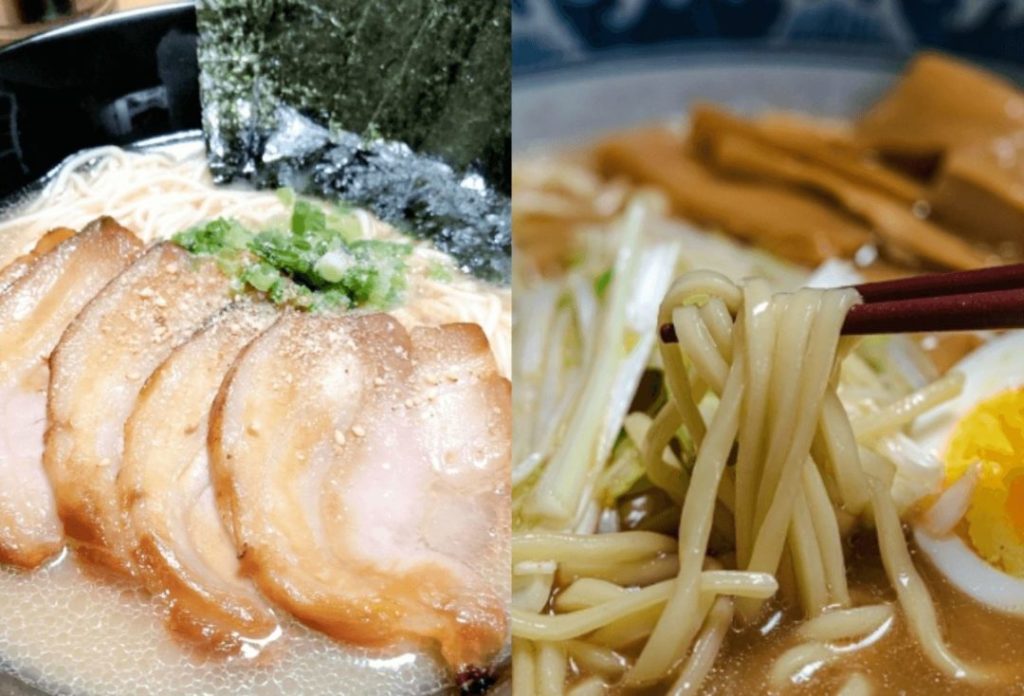
History

“Ramen” has its origins in “Ra-men,” which originated in China. The word “Ra” means to pull and stretch long and “Men” means Chinese noodles.
Japanese ramen uses lye water (an alkaline salt solution) to give needles a firm texture. The soup and toppings used in Japanese ramen are very different from those in Chinese ramen. It is also popular in China as “Japanese-style ramen.
It is said that ramen got its start at the end of the Edo period (in the 19th century) when many foreigners moved to the port cities such as Yokohama, Kobe, Nagasaki, and Hakodate, and Chinese ramen was introduced at this time.*
In 1910, the Chinese restaurant “Rairaiken” opened in Asakusa, Tokyo. Chinese chefs were invited from Yokohama Chinatown to serve ramen created by a fusion of Chinese ramen and Japanese food culture. At that time, ramen was called “Shina soba” (Chinese noodles).
After World War II, many ramen stalls were set up by people repatriated from mainland China, and over the past 100 years, ramen has developed into a uniquely Japanese menu item with many different arrangements until the present day.
*Japan has opened several ports a the end of the Edo period after restricting interaction with foreign countries for a long time.
Features
Ramen by Region
Hakata Ramen / Kitakata Ramen
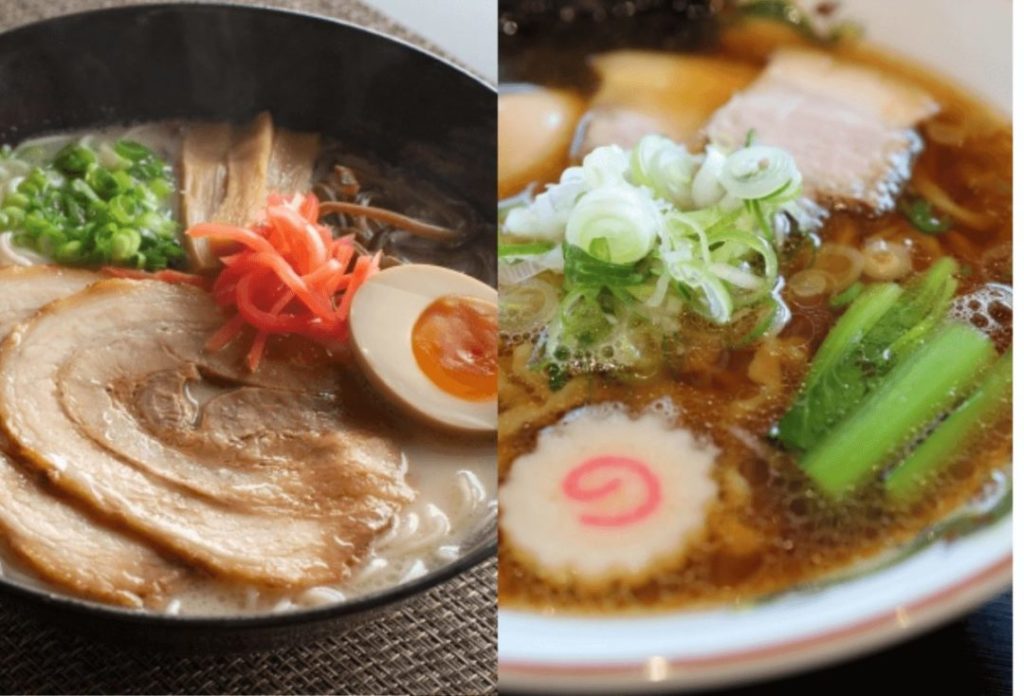
First and foremost, tonkotsu (pork bones) ramen is popular both in Japan and abroad. “Hakata ramen” is a representative player. It uses thin straight noodles. The soup is characterized by a cloudy white color, which is made by boiling pork bones over high heat to dissolve the collagen in the bones. The noodles can be refilled with additional noodles which is called “Kaedama”.
“Kitakata ramen” is a representative of soy sauce ramen. Overseas, soy sauce ramen is second only to tonkotsu (pork bones) ramen in popularity.
Hakodate Ramen / Sapporo Ramen

“Hakodate ramen” is a light salt-flavored ramen, and “Sapporo ramen” is a thick miso-flavored ramen.
Kumamoto Ramen / Nagasaki Champon

“Kumamoto ramen” combines tonkotsu (pork bones) and chicken bones broth. The chicken broth softens the strong flavor of the pork broth making the soup milder than Hakata ramen. It is also characterized by the addition of black Ma-yu (fried garlic oil).
“Nagasaki champon” is made with more than a dozen stir-fried ingredients, including pork, seafood, vegetables, and kamaboko (fish cake), in lard. The word “Champon” means to mix various ingredients. The flavor of the vegetables is blended into the soup.
Toyama Black Ramen / Okinawa Soba

“Toyama black ramen“ is characterized by its black soup made of dark soy sauce. The soup is salty and is usually served with white rice.
“Okinawa soba” is made with pork bones broth, but it also contains bonito dashi (Japanese soup stock), giving it a unique flavor that is somewhere between ramen and udon noodles. Okinawa is geographically close to Taiwan and southern China, and this unique cuisine has developed under the influence of both Chinese and Japanese cuisine.
Ramen by Topping & Eating Style
Wonton Men / Char-siu Men

“Wonton men” (wonton noodles) is ramen topped with wontons. “Wonton” is Chinese flour dumpling stuffed with meat, and wonton men is very popular.
“Char-siu (roasted or simmered pork) men”, ramen with a pile of char siu, is a popular menu item. Char siu is a typical topping for ramen, and this is the most coveted ramen with chashu as the main topping.
Curry Ramen / Ankake Ramen

“Curry ramen” is a combination of two popular menu, curry and ramen. Chinese soup and curry go well together. When eating the noodles, be careful not to splash the soup and get stains on your clothes!
“Ankake” ramen is made by stir-frying seafood (shrimp, squid, etc.) and vegetables (leeks, shiitake mushrooms, bamboo shoots, etc.) and thickening them with potato starch before pouring them over the ramen. As one eats the ramen, the flavor of the ingredients enclosed in the thickening gradually dissolves into the soup. Along with Nagasaki champon, this ramen is good to get lots of vegetables!
Tsuke Men / Ae Soba

“Tsuke men” is ramen without broth, and is eaten while dipping the noodles in a thick dipping sauce. You can control how much of the noodles are dipped in the sauce, for instance, you can dip only half the length of the noodles in the sauce and enjoy both the taste and texture of the noodles itself and the taste of the noodles together with the sauce.
This is the same way of eating “Zaru soba”, one of the Japanese soba noodles. Ingredients such as shinachiku (seasoned bamboo shoots) and boiled egg can be enjoyed by themselves dipped in the sauce, or mixed with the noodles and dipped in the sauce together. You can eat it the way you like it.
For more information about zaru soba, please check it from here: “8 Japanese Foods to Learn About” / “Soba”/”Soba with Dipping Sauce & with Warm Soup”
“Ae soba” has thick sauce at the bottom of the bowl. Mix the sauce with the noodles as you like and eat it. You can mix it in completely, or you can mix it in a little at a time, just enough to eat. The concept of Ae soba which you can control the quantity of sauce to mix is similar to that of Tsuke men, but the difference is that in the case of Ae soba, ingredients other than noodles are also included in the bowl from the beginning, and the noodles and ingredients are eaten together.
More Deep Stories
The Secret of the Ramen Shop
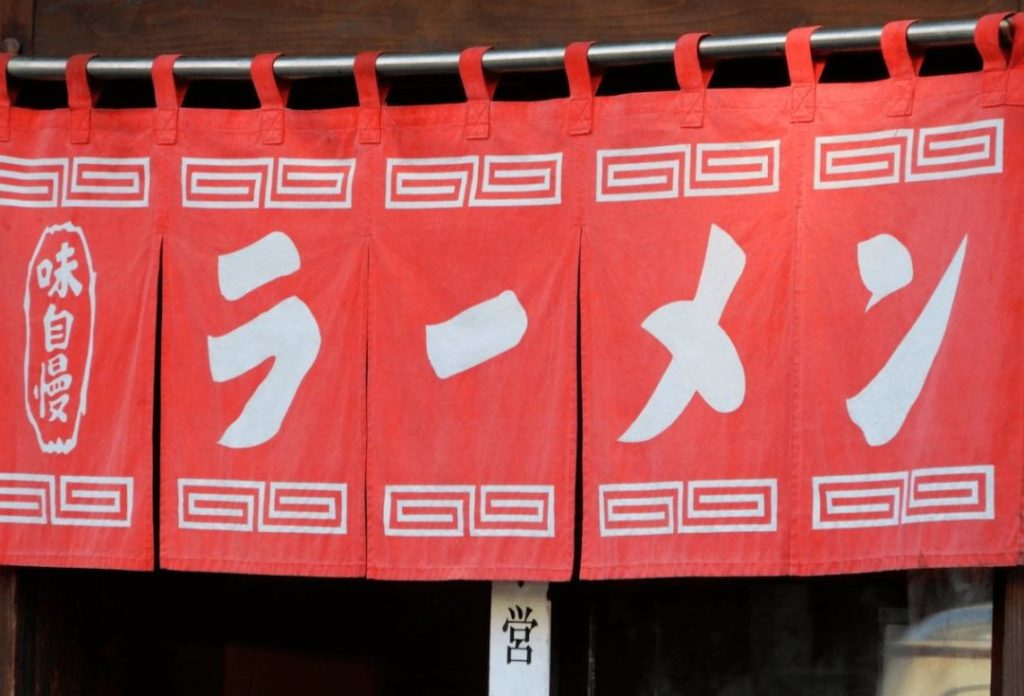
Ramen shops have a magical power. Ramen shops can be found all over the city, and a bowl of ramen with its flavorful broth and carbohydrate noodles is enough to satisfy one’s appetite. In addition, that’s for a reasonable price of around 1,000 yen.
When you order ramen, it comes out in a surprisingly short time. What makes this possible is the ramen shop’s cooking system. When an order is received, noodles are cooked in a stockpot in which water is boiled in advance. While the noodles are cooked, a bowl is filled with a compound seasoning prepared in advance, and then broth made with chicken, pork, seafood, and vegetable etc. is poured into the bowl to dilute seasoning into ramen soup.
The noodles are then placed in the bowl, topped with separately prepared ingredients such as char siu (roasted or simmered pork) and other ingredients, and served. The ramen is served in just a several minutes.
Whenever you want to eat, you can choose the type of ramen you want at your favorite ramen shop and can eat it straight away with reasonable price, giving sense of fullness. There is no doubt that you are addicted.
The secret of ramen’s popularity is its addictiveness

Why does ramen taste so good and why do we want to eat it again and again?
The most important secret is its umami (pleasant savory taste)-rich broth.
In traditional Japanese cuisine, dashi(Japanese soup stock) out of bonito flakes or kelp is usually used alone, or with a combination for umami. On the other hand, umami extracted from multiple ingredients such as chicken bones, pork bones, dried bonito flakes, and kelp are condensed in ramen soup.
For more information about dashi and umami, please check it from here: “8 Japanese Foods to Learn About” / “Dashi”
In addition, noodles made of wheat flour are a carbohydrate, and char siu (roasted or simmered pork), which is often used as an ingredient, contains animal fat.
In other words, ramen containing abundant of umami, carbohydrates, and animal fat is a food that the body craves because it has all the elements that make it taste good to the brain.
Another interesting finding is that after drinking alcohol, people crave ramen. However, eating ramen on top of alcohol and snacks can lead to excessive calorie intake, so care should be taken to control the frequency of eating ramen after drinking.
Tender Char Siu That Can Be Cut with Chopsticks
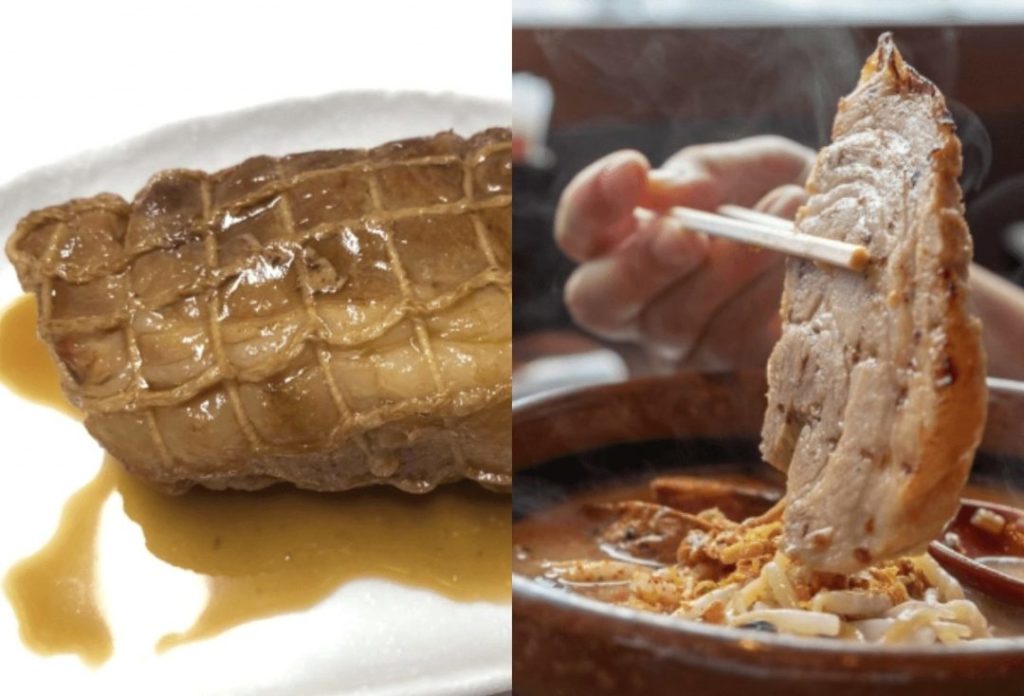
There is no doubt that the most popular topping in ramen is char siu (roasted or simmered pork). Originally a Chinese dish, char siu is made by marinating a block of pork in soy sauce and other seasonings and then roasting it. In other words, it is roasted pork.
Some Japanese ramen noodles also have char siu made in this way, but most are made by binding a block of pork with strings to prevent it from falling apart and then simmering it with soy sauce, mirin (sweet sake), sake, and aromatic vegetables.
The char siu made this way is so tender that it can be cut with chopsticks, and it falls apart in the mouth. The delicious flavor of the pork and fat that has absorbed the seasoning liquid fills the mouth and is irresistibly delicious.
Some ramen shops serve ramen with multiple types of char siu made of different parts of the pork in a bowl, and some ramen shops serve ramen with both roasted one and simmered one in a bowl. Some shops serve ramen with char siu made of chicken which has lighter taste.
Soba(Japanese Buckwheat Noodles)

History
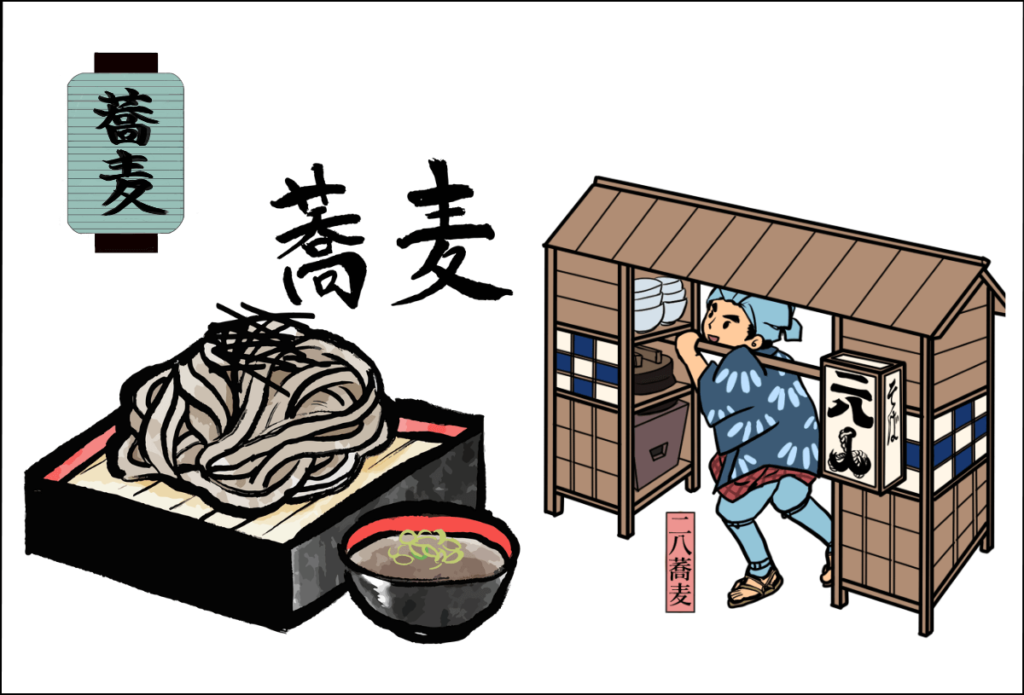
“Soba” is a noodle dish made from buckwheat flour. There are records that buckwheat have been cultivated since the Nara period (since the 8th century), and in ancient times it was eaten as “Soba-gaki,” made by kneading buckwheat flour and then cooking it in boiling water, which was later transformed into the present “Soba”, which are cut into long strips and cooked in boiling water.
It is said that soba became popular in Edo (present-day Tokyo) in the middle of the Edo period (in the late 17th century). Soba, which can be served in a short time, may have suited short-tempered Edo people.
It seems that Edo people thought it was chic to eat soba as if swallowing it without chewing it too much in order to enjoy its smoothness over the throat.
Soba is so familiar to Edo people that it is often used as a theme in “Rakugo” (traditional Japanese comic storytelling). In rakugo, a rakugo storyteller often uses a closed fan as chopsticks to eat soba. In today’s rakugo as well, audience applaud at the scene of eating soba.
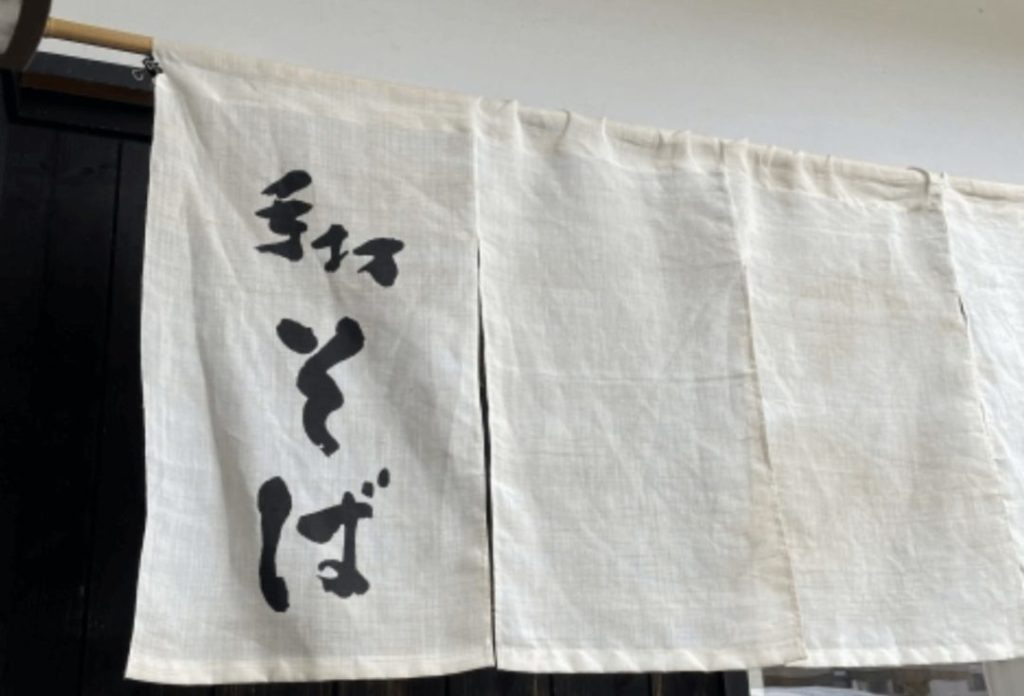
It is said that there are more than 18,000 soba restaurants throughout Japan. In addition to eating soba as usual meals, many Japanese people eat “New Year’s Eve soba” on New Year’s Eve. Soba is easier to break when eating than other noodles such as “Udon” (Japanese wheat flour noodles), so it is said that the meaning of eating “New Year’s Eve soba” is to cut off the bad things that happened this year once and for all. It is also believed that it is to wish to live a long life like soba.
Features
Soba by Proportion of Buckwheat Flour and Milling Method
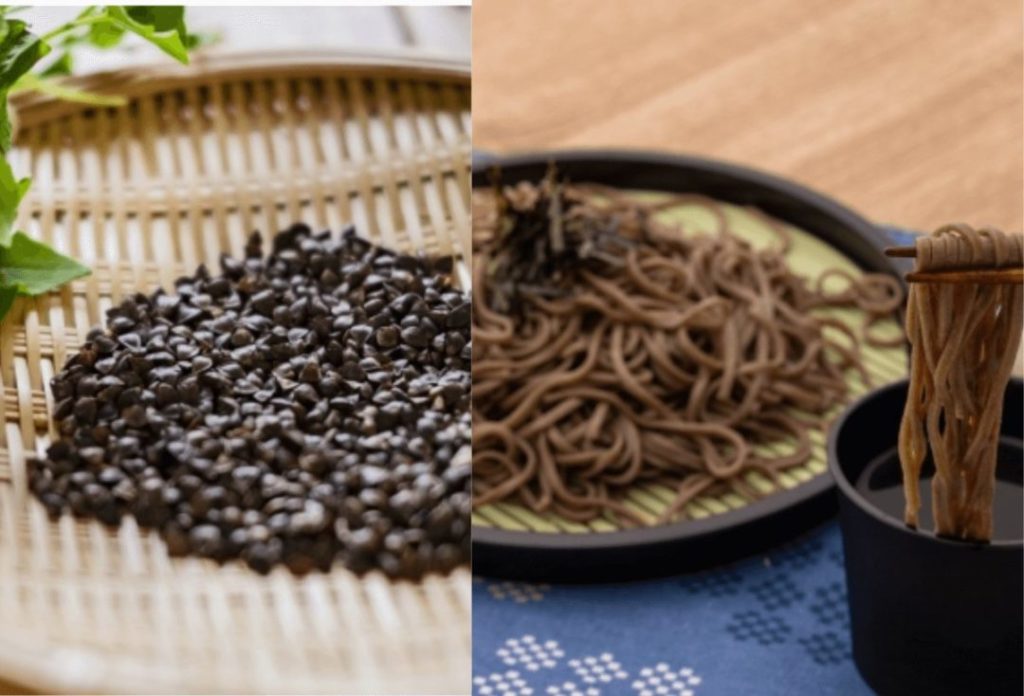
Soba is usually made with wheat flour as a “binder” in addition to buckwheat flour. This is to add suppleness and smoothness to the noodles.
Soba made with 100% buckwheat flour is called “Juwari soba”. When chewed, juwari soba is rich in buckwheat aroma which spreads in the mouth having crispy palate feeling.
Soba made with 80% buckwheat flour mixed with 20% wheat flour is called “Nihachi soba”. This soba offers both a smooth texture and a pleasant buckwheat aroma. There are various other types of buckwheat noodles made with different proportions of buckwheat flour.
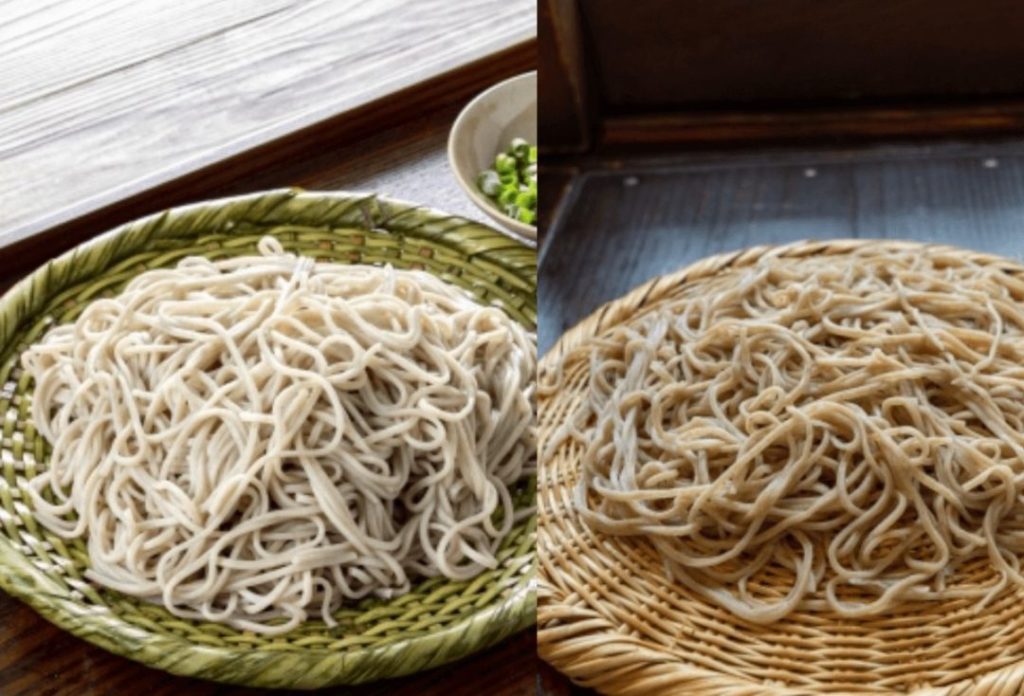
Even the same buckwheat flour has different characteristics depending on the milling method, and the taste of soba produced will also vary.
“Sarashina buckwheat flour”, which is white and consists only of the center of the buckwheat seed. Sarashina buckwheat flour has a weaker buckwheat aroma, and it produces delicate soba with a sweet taste. Hikigurumi-type buckwheat flour is made by grinding the skin and other parts of the buckwheat together, making darker-colored and more aromatic soba.
Soba with Dipping Sauce & with Warm Soup

When it comes to talk about soba, many people probably think of mori-soba or zaru soba, which are cooked in boiling water and cooled down in a cooled water, and are eaten with “Soba tsuyu” (dipping sauce made from soy sauce, mirin: sweet sake, dashi: Japanese soup stock etc.)
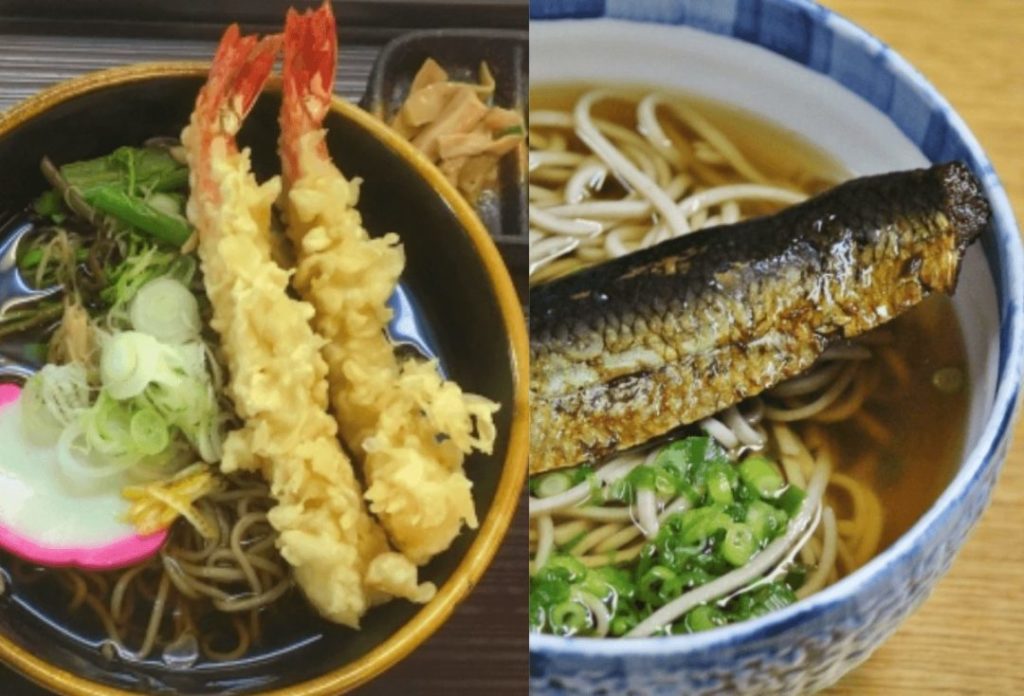
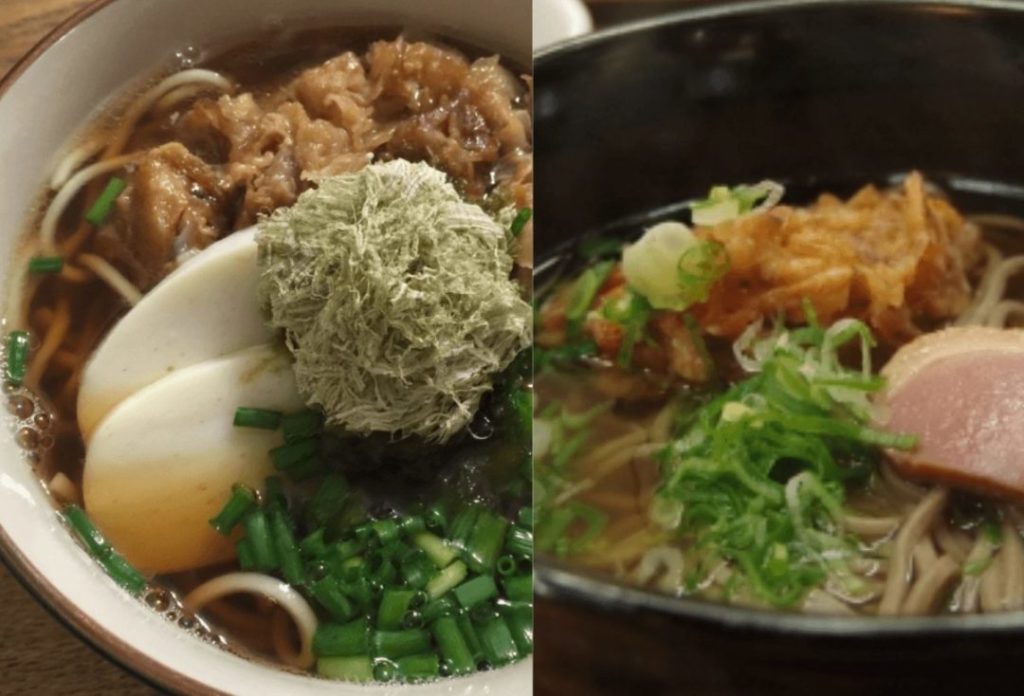
On the other hand, there is also “Shiru soba”, which is served in warm soup. Shiru soba has many variations. “Kake soba” is shiru soba without any toppings. Tempura Soba” is topped with tempura (Japanese deep-fried dish), and the flavor of the tempura melts into the soup, creating a mildly delicious taste. Looking at others, “Nishin soba” is with herring, “Niku soba” is with beef, and “Kamo namban soba” is with duck meat.
Soba Mixed with Other Ingredients

Soba can be kneaded with various ingredients. The most famous example is “Cha soba,” which is made by kneading matcha (powdered green tea) into soba. Although it is rarely practiced nowadays, in the old days, three to five colors of soba were offered on the Girls’ Festival altar, and the family ate them after the event was over. Sakura shrimp (small pink shrimp), eggs, and matcha were kneaded into. There were also soba kneaded with pickled plum and with black sesame.
More Deep Stories
Soba Yu
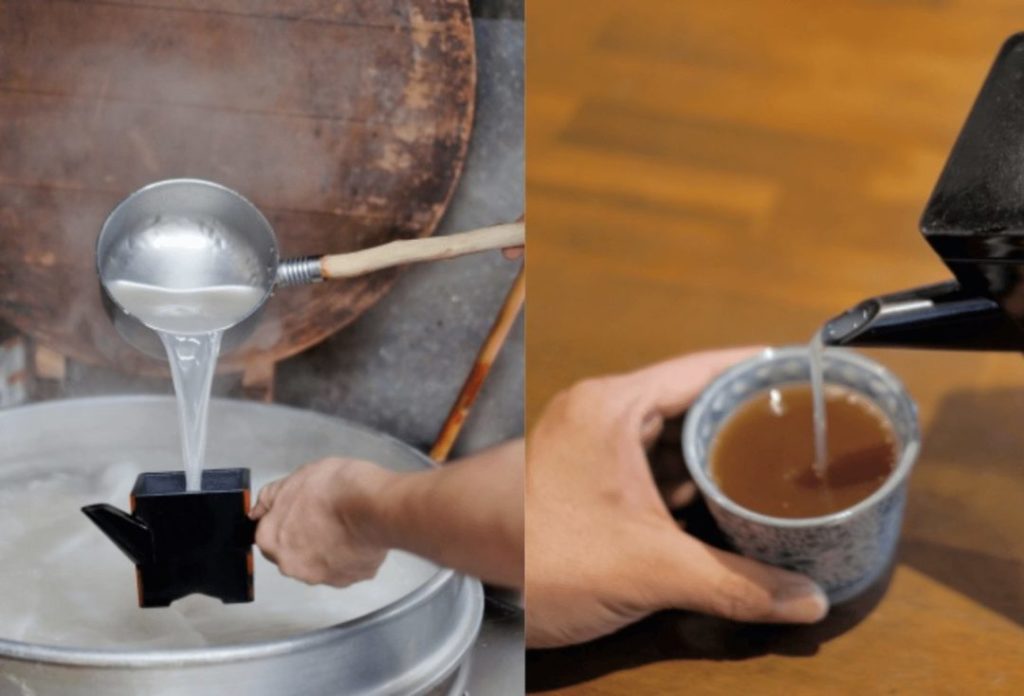
Soba has fewer calories than other grains and contains a large amount of protein, vitamins and minerals etc.
Much of protein, vitamins and minerals etc. leaches out into the boiled water. Drinking “Soba yu” (boiled water after cooking soba) is a good way to take in the nutrients leached out in the boiled water. Usually soba tsuyu (dipping sauce made from soy sauce, mirin: sweet sake, dashi: Japanese soup stock etc.) is diluted with soba yu to drink. It is said that this custom has been practiced since the Edo period (since the 17th century).
Soba making experience is popular among foreign visitors to Japan

It is getting popularity to experience Japanese cultures by themselves or to attend events for foreign visitors instead of merely buying and eating something. One of the most popular examples is the soba making experience.
It is popular because soba has a healthy image, and soba craftsmen instruct you on how to make soba from the basics in English in an easy way to understand. Moreover, you can eat the soba you made yourself at the end of it.
Actually, participating in the soba making was quite enjoyable for them to experience something new. For example, they experience to cut the soba into long strips with a unique shaped special knife which never happen to pasta. Many people seem to be satisfied with the experience as they think they can learn more about Japanese food culture by actually making their own soba.

